A tribute, review, research and documentation weaved as one, this is a thread of threads in collating essential, basic information as well as trivial know-hows on Nitecore D10. It's not exactly a new light, but because of that, much has been explored. I also hope this serves as a wiki-platform for others who seek answers to common or recurring queries, to reach an informed decision, to solve issues and also for me to impart the joy of having this light. For the record, I have no affiliation with Nitecore or its dealers other than being a customer.
When I first joined CPF, like many, I sought for the first entry level edc to start on this path of no return. I wanted something handy, compact, affordable, easy-to-use, takes in universal AA, bright and definitely not the least, looks good. Seemed like a tall order, but I found Nitecore D10. That began my journey in exploring this innovation by Nitecore (established by Edgetac) & 4Sevens, and I ended up having a good time researching and reading up a wealth of information on this light.
It is exactly one year after I registered as a CPF member and all these while, like a boy in a candy store, I have eagerly bought and played with many lights. Some came and stayed and most sold to fund for newer and better stuff. But the D10 has stayed from day one, which I have come to depend on as an edc, a backup, a backup's backup, a backup's backup's backup, well, you know the drill. Should it come to pass I am to choose one and let the rest go (stock lights), I'll pick D10. Why do I like it so?
---------------------------------------------------------------------------------------------------------------------------------------------------------
ADVANTAGES
---------------------------------------------------------------------------------------------------------------------------------------------------------
Based on my user experience, Nitecore D10 has the best balance of all features. It may not be the brightest (although it's still one of the brightest AA lights today), but it makes up through efficiency. It is not the smallest, so that it's at the right size to be grasped by my hand. It is not the most expensive, so it will not be a shelf queen. It is not rare, so that we can have more of it.
The qualities I treasure in D10 are many. I shan't go into the technical details for I defer to the experts here who have done a far greater job in sharing their reviews (links below). So, as a user who is technically challenged (numbers scare me), my reasons are thus...
On top of being my first edc (you remember your first love, don't ya), I always have a weakness for tubular form. That began with my earlier purchases besides D10; Maglite Solitaire, the Fenix L2P and Jetbeam E3P. There's always something appealing about the simple beauty of a tube and I'm glad D10 didn't go beyond that other than adding some very good knurling for a reassuring grip.
Also, D10 can be used as a twisty or a "clicky", both ways allow one-hand operation to control activation. One of the key features of D10 is that it employs the Smart Piston Drive (PD) System, a wonderful brainchild of McGizmo; the PD is a piston within the light body that houses the battery and depressing the switch (top part of the piston protruding out of the tail end) will activate the light through the switching mechanism in the head.
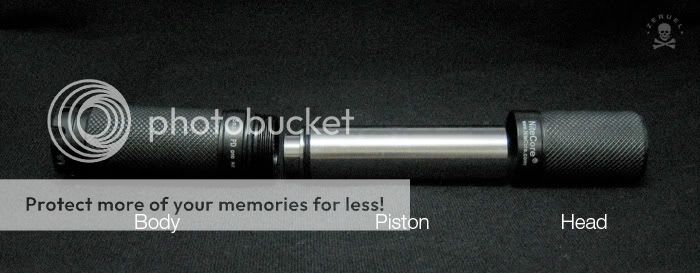
When I first received the D10, I wasn't accustomed to the PD system because, unlike the traditional clicky, it has a short traverse and doesn't resonate with a reassuring "click" to affirm activation. But very shortly after, I got used to it and grew to like this silent PD feature. In fact, it became my default light for that flashaholic's clicking fetish.
In the absence of a traditional clicky switch, there are lesser parts to wear off and take care of. And naturally, I would think a metal switch would outlast a rubber boot (boot refers to the rubber cap of a switch) in extreme circumstances like fire, corrosive liquid spill, scraps, cuts etc. The flat tail end of D10 provides candle mode (tail-standing) capability, something I find essential for indoor usage. The PD also enhances switch reliability and reputed to be safe for activation in a flammable environment due to this electronic switching method.
The light uses the ubiquitous AA battery of any kind, namely primary, alkaline, Nimh or Li-ion so there's no fear in finding spare batteries for this light virtually in any part of the world (unless you're lost in the woods). With a primary AA, the light can run up to an impressive 45 - 100 hours on minimum setting, depending on the D10 model. And it does notably run brighter (up to R2 XR-E) on rechargeable Li-ion than the rest (source) but take note of the minute size differences of different Li-ion brands, some are longer than others which might disable the function of the PD. On my end, I have no trouble using AW 14500. And also in the latest versions, running D10 on NiMH and Li-ion will not show much of a difference in output (approximately a difference of 8 lumens only).
This compact light can withstand lots of abuse, more abuse that I would have imagined when I bought it. You can view the video links below to attest to this. It's aggressive diamond-textured knurling maximizes grip and has an almost therapeutic effect to hold it in your hand. Needless to say, it also provides good grip to use the light as a twisty and unscrewing the body for battery replacement, such is a piece of cake for handling even for greasy or sweaty hands. However, the D10s in my possession show the knurling has lost a tad of bite in the later R2 version compared to the earlier Q5 and Golden Dragon Plus counterparts but seemed to revive the bite in the latest SP R2 version.
Last but not least are the many fine details that went into the construction of the light to ensure overall build quality. To name a few, solid aluminum reflector (tougher and better heatsink), diamond double-coated lens (impact resistant with anti-reflective), gold-plated battery contact spring (better conductivity) and solid brass contact ring (solidity and conductivity).
---------------------------------------------------------------------------------------------------------------------------------------------------------
USER INTERFACE
---------------------------------------------------------------------------------------------------------------------------------------------------------
D10 (R2 and earlier)
The benefits of the PD system are many. By means of the micro processor in the head, the light output can by programmed by ramping to any value between 3 to 145 lumens, a low low, a bright bright and any level in-between. Function-wise, D10 gives you quick direct access to minimum or maximum output; Double click to get lowest, click and hold to get highest, or just hold down to ramp up or down to choose a brightness level (Infinitely Variable Digital-controlled Brightness System). Its memory mode enables the light to retain the last output setting. Pretty much a simple and easy-to-use interface. And there's no strobe and SOS mode to irritate the heck out of me. By untwisting the head simply by half a turn, it allows the PD to be used as a momentary switch. This also acts as a deterrent measure against accidental activation.
Here's an explanatory video on the workings of the PD system (Ramping Versions). And further discussion of the system can be read here.
D10 SP (R2)
The latest D10 SP R2 has deviated from the UI of the standard version to offer a further simplified UI and strobe/SOS to those who wished for it. It's updated with a XP-E R2 and a slightly more dimpled reflector, thereby enabling a buttery smooth beam profile.
Besides using XP-E R2 emitters, it has replaced the ramping feature with a 3 pre-set outputs of 2 lumens (100 hours), 35 lumens (6 hours) and 130 lumens (1 hour). Compare that to D10 R2 which outputs 3 lumens (45 hours) to 145 lumens (50 minutes), I'd say there's a surprising improvement, ie twice the runtime on low mode!
It also seems there were requests for SOS/Strobe which is now incorporated into D10 SP. Much to my relief, this feature is hidden, meaning the user doesn't need to cycle through SOS/Strobe modes to get to the regular output setting. I also applaud the implementation of the digital lock-out feature which prevents accidental activation.
I am surprised by the introduction of D10 SP, given that SOS/Strobe is generally not a popular feature (as far as I see) and the most unique part of the light, the ramping capability, to be replaced with 3 pre-set levels. However, the SP Edition does fill the need for some who wants simplicity and such strobe features. I certainly welcome the digital lock-out function and the buttery smooth beam profile of the XP-E R2. I'm glad to to have given SP the benefit of the doubt by trying it out. It turned out not too bad, contradicting my initial judgement.
Here's basically how the features work:
When light is on, press and hold to cycle through min, med and max to choose level. This step-up switching occurs less than a second, a good speed that enables accurate mode selection and also not too slow for cycling for the next loop. This mode selection can also be done when the bezel is loosen to enable momentary-on mode. However, even if it's termed as momentary-on, loosening the bezel only allows mode selection, the light cannot be used momentary-on because mode switching will activate in less than a second.
While the light is on, double-click to enter SOS or click and hold (1 click and hold down on the second click) to enter strobe mode. For my SP, the speed of the SOS seems odd. It goes through a cycle of 3 SOS. It starts off with a fast SOS, a slow SOS and then a fast SOS. The cycle then loops.
To avoid accidental activation, simply press and hold while the light is off. A short flash will indicate safety lock-out mode is enabled. Triple click the tail cap to activate the light again. I think this is the best new feature to be implemented.
---------------------------------------------------------------------------------------------------------------------------------------------------------
REVIEWS
---------------------------------------------------------------------------------------------------------------------------------------------------------
Here're some in-depth reviews consisting runtimes, readings, part-by-part descriptions and opinions by the reviewers I mentioned earlier.
Selfbuilt's Reviews:
D10 SP
D10 GD+
D10 Q5
Unknown's Review:
D10 Q5
CPFreviews:
D10 Q5
Mini Review of D10 SP
There're 2 version of SP so far. For simplicity, I'll name them 1st and 2nd Editions. The 1st Edition has the same hardware as the ramping R2, the only physical difference as far as I can tell, is the marking on the head and the color of the circuit board.
Whereas for the 2nd Edition SP, the distinct physical change is the relocation of the piston o-ring and the recess in which this o-ring operates. The new position of the o-ring is supposedly to make activation easier compare to the previous versions with which users found it stiffer to depress. By comparing the activation between the old and new pistons, I feel no difference in the ease of activation. However, I did clean and lubricate the older pistons before using. The ease of activation from the new SP is evident out-of-the-box. However, doing a double click to get SOS and a click & hold to get Strobe require slightly more effort now because of a longer traverse and a sluggish reaction from the o-ring.
In terms of waterproofing, I believe there's an improvement over the older models. There is a what appears to be a 0.5mm gap between the piston button and the body for the previous D10 and this might allow smaller particles like fine sand to enter and settle in the space between the o-ring and the entry point. For the new piston system, the gap is almost negligible and with the o-ring higher up, chances of dirt and water residue remaining in the tail portion is minimized.
The 2nd Edition SP comes in 3 finishing; Camo, Dark Brown and Light Natural. For this thread, I've included the Light Natural version. Below are some images showing the physical differences of the old and new.
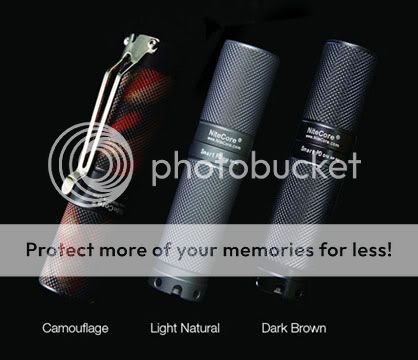
Camo, Light Natural & Dark Brown (never released)


Taller recess for the new o-ring position
---------------------------------------------------------------------------------------------------------------------------------------------------------
VERSIONS
---------------------------------------------------------------------------------------------------------------------------------------------------------
Here is a compiled list of all D10s from the past to the present, from the mass to the very limited.
1] Stock D10s
2] Hybrid D10s
3] Special Anodized D10s
4] Custom-made Titanium D10
5] Limited Edition Titanium D10
6] D10 Tribute Edition
7] D10 SP Warm
8] Exotic Coated D10
9] Others
1] Stock D10s
These D10s are mass produced for the market and it started with the Q5 till today's R2 (XP-E). There is some confusion created by the newest because of custom-order by the Hong Kong distributor. This involved intermixing new hardware with previous software (which is more popular), but these "hybrids" are not mass-produced.
In order of release for stock D10s:
Q5 – Black. Ramping UI.
GD+ – Black. Ramping UI.
R2 (XR-E) – Black. Ramping UI.
SP R2 1st Edition (XP-E) – Black. New UI.
SP R2 2nd Edition (XP-E) - Light Natural, Camouflage & Dark Brown (never got released AFAIK). Revised PD system and New UI.
Ramping = Infinitely Variable Digital-controlled Brightness System
Hybrid refers to new PD system (hardware) with original ramping user interface.
Emitters Q5, R2 (XR-E) and R2 (XP-E) are from LED manufacturer CREE.
Golden Dragon Plus is from OSRAM.
In terms of mass-produced D10s to date, there're 5 versions differentiated mainly by their emitters; Q5, Golden Dragon Plus (GD+), R2 (XR-E) and 2 versions of SP R2 (XP-E).
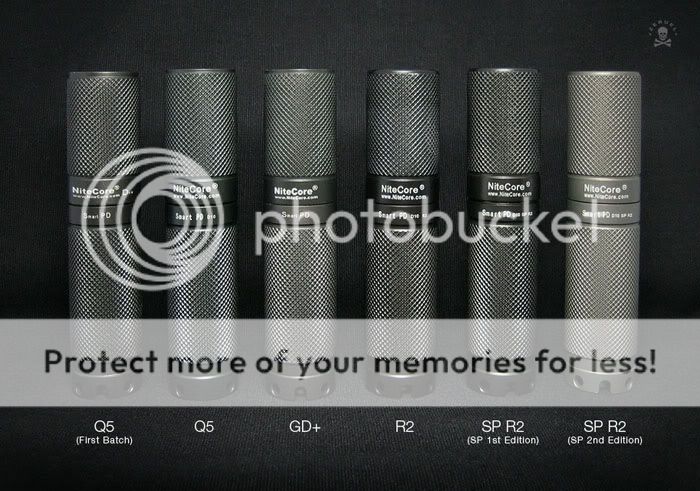
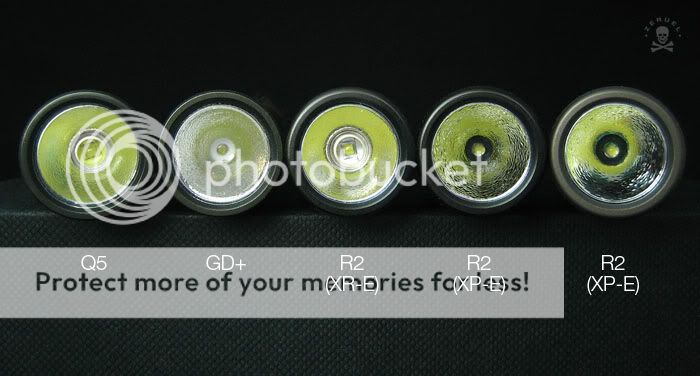
D10 Q5
The introductory D10 uses the Q5 emitter. The original version has an inscription of "D10" on the head but the inscription has dropped down to the body section in later batches. The first batch of D10 has a very thin bezel rim which I have my doubt if it would survive a drop head on, so as to speak. This was later improved with thicker rims for subsequent batches till today. Type 3 hard anodizing appears very dark grey and has a very good grip provided by the aggressive knurling. This version has phased out and is discontinued, but are still available from less than a handful of dealers.
D10 Osram Golden Dragon Plus (GD+)
Body is similar to Q5's in terms of color and knurling. No markings of any sort to show it's GD+, just Smart PD D10. The most limited run of the 4, this version has phased out and is discontiunued. Once in a while, It might be available through WTS section in CPFMP.
D10 R2 (XR-E)
The latest regular version to date. The body of the R2 has thickened by 0.5mm to further strengthen the wall. That's a good consideration from Nitecore, but I found out it no longer fit into kydex holsters as easily as the former versions although soft holsters using nylon and leather are not a problem. Anodizing for earlier R2 batches appears black and knurling seems to have lesser grip than its predecessors. The later batches seemed to have reverted to knurling similar to Q5. The light has a R2 marking on the body. Leftover stock available from some Nitecore dealers although it's discontinued.
D10 SP R2 (XP-E) 1st Edition
This is marked with D10 SP R2. It has a somewhat rounder lip of the head and the knurling is similar to the aggressive texture of Q5's. The color of anodizing is closer to black than grey, but then this might differ from batch to batch. The traverse to activate the switch is the longest amongst all versions, seems like a modification is made to the switch ring to do that (furthest distance from the circuit board). D10 SP and later batches of D10 R2 have similar body characteristics. Stock available from some Nitecore dealers.
D10 SP R2 (XP-E) 2nd Edition
Physically similar to 1st Edition with the exception of using a new PD system and 3 anodizing options. Stock available from some Nitecore dealers (depending if the stock has been updated).
2]Hybrid D10s
These are customized limited runs requested by the distributor in Hong Kong. All hardware (including emitter & reflector), anodizing and packaging are identical to SP except for the UI, which uses the original ramping interface and this presents a best-of-both-worlds option for those who prefer ramping. Identify a hybrid by its marking (it should just read D10 R2), new piston o-ring position and a red circuit board (which is almost similar to SP's). This version comes in XP-E and XR-E. Since it's using identical emitter and reflector, the beam profile is similar to SP, but tint lottery is evident for both of my XP-Es where I have one slightly warmer than the other.
R2 Hybrid (XR-E & XP-E) - Black & Light Natural. Revised PD system with Ramping UI.
Note that terms like "1st, 2nd Editions & Hybrid" are stated by me for simplicity and they are not official terms used by Nitecore or its dealers.
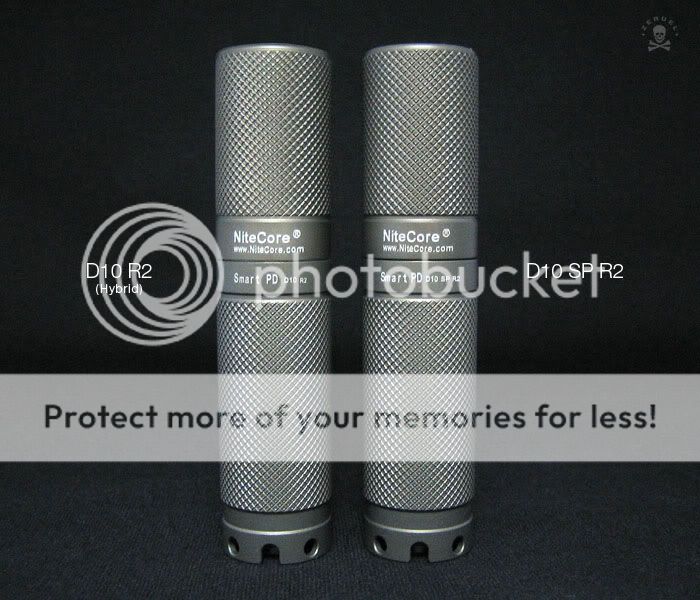
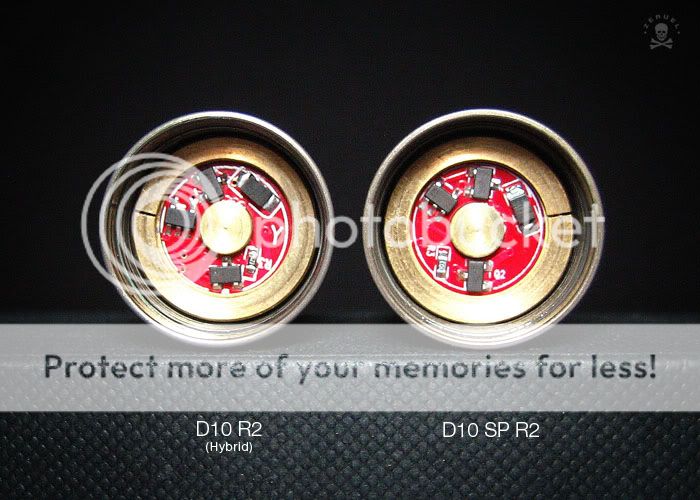
Available in Light Natural & Black only.
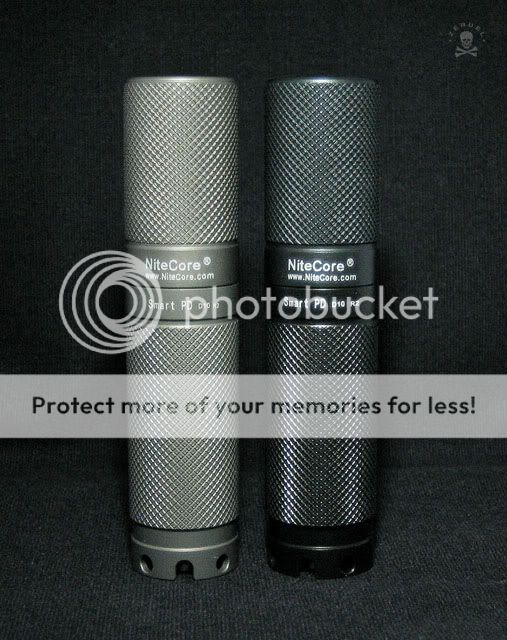
3] Special Anodized D10 by Swissbianco (Limited Edition)
This series of Limited Edition D10s are available with Q5 emitters employing first batch's body. Only 25 of each design are produced and they're serialized. Available from 4Sevens and selected CPF dealers (update: sold out). Anodizing was done by Swissbianco.

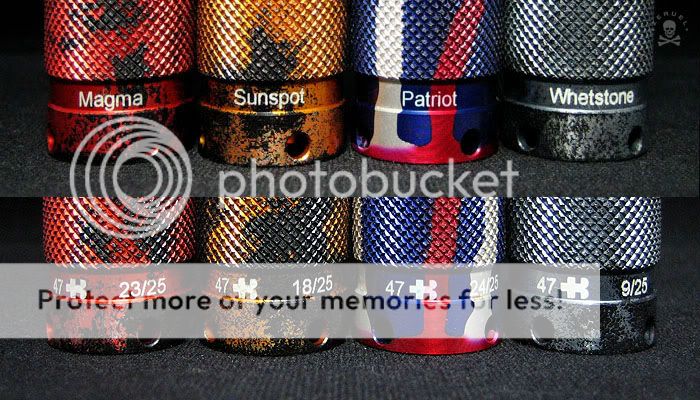
4] Titanium D10 by JHanko (Custom-made)
These are magnificent titanium versions of the light, pieces that D10, titanium and even tritium lovers would drool over. These titanium hosts are created by, what I would consider, a master at what he does. They are considered to be the holy grail of D10s, underlined by the rarity of AA titanium lights available. Shown here is the latest development employing "3D Tritiums", a smart innovation that later inspired many others. The convenient aspect of a titanium D10 is it uses the light engine from any stock D10, hence it can conveniently be replaced for fault remedy or for upgrades. If you get enough stock D10s (specifically the engines) and with one of these grails, you could literally use the light for a long time and maybe someday, hand it down to your kids.

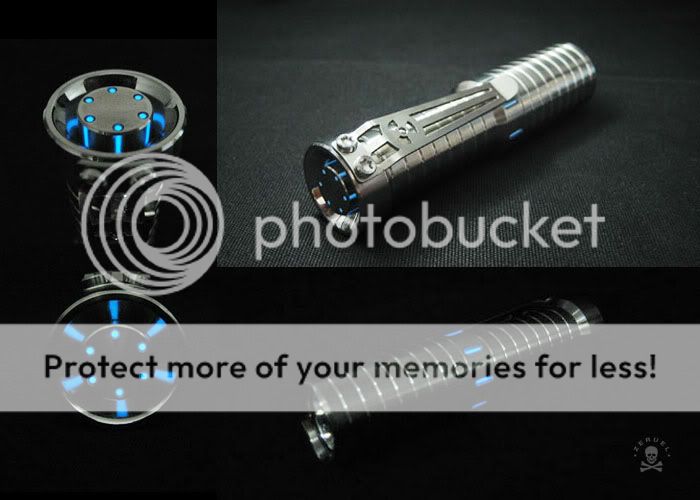
Titanium D10s are designed and produced by Jhanko (aka Jeff). A great thanks to Jeff for the Ti D10 with ice blue trits.
5] Titanium D10 by kuku427 (Limited Edition)
This titanium D10 has identical design as the stock version. So far, only 10 are produced for this short run, each set includes the head, body and the tritium-slotted (1.5 x 5mm vial) piston. Due to popular demand, another set of titanium D10 was produced at a later stage. The only different between the first and second batches are the number of tritium slots on the piston; first batch has one whereas second batch has two. A beneficial difference from the stock is that it uses square threading for added strength. Likewise, it can take in light engine from any stock D10, including the latest SP.
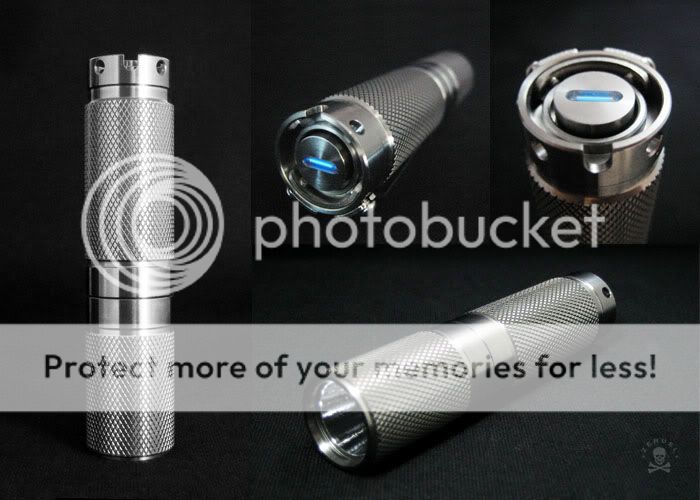
Dealer for Titanium D10s is kuku427 (aka Steve).
6] D10 Tribute Edition by Battery Junction
This D10 is initiated by Matt (Battery Junction) as a Tribute light in tribute to this tribute thread. :laughing: To be precise, this is a D10 Hybrid with TRIBUTE laser engraved on it. Meaning it's using the new PD system, has a ramping UI, similar LED (R2 XP-E) & reflector and an identical smooth beam (see D10 SP R2 XP-E) to the Hybrid. Again, I find the initial ramping up a tad too fast, which is not as gradual as ramping down. But I think I'm just nitpicking.
On top of being a limited edition (400 pieces in 2 separate batches of 200), like the Hybrid, it offers a best-of-both-worlds scenario for users who prefer the ramping UI encased in the new piston drive system. However, there're a few physical differences in this special package as shown in the following...
Once again, Nitecore has revised their packaging. I believe this is the 4th version (see "PACKAGING" for size comparison) for latest D10 in general and it's not for D10 Tribute per se since there's no printing indication to show this new packaging is exclusively for the Tribute. It has become shorter than the previous one, which I'm glad for as it's less cumbersome and better use of space. The vermillion (orangy red) band is now red. What was previously an internal paper tray is now a plastic-molded tray with a sponge inlet to cradle the light. I guess the reason for this change is the paper version distorts easily during packaging and transportation, causing the light within to be displayed off-side and it also doesn't really hold the light well. My Tribute package doesn't come with spare o-rings and lanyard, but IMO this is compensated by extra bonuses mentioned below.
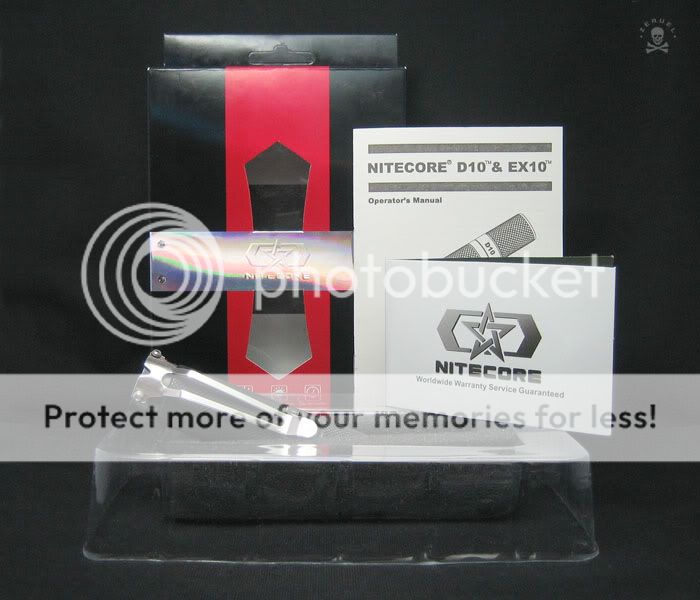
Obviously, "TRIBUTE" is boldly laser-engraved on its body. I removed the clip to show it in its full glory. My sample has a slight anodizing discrepancy, head is dark gray and body is black. So I guess some buyers will get grey ones, some black ones and some others will get 2 tones.
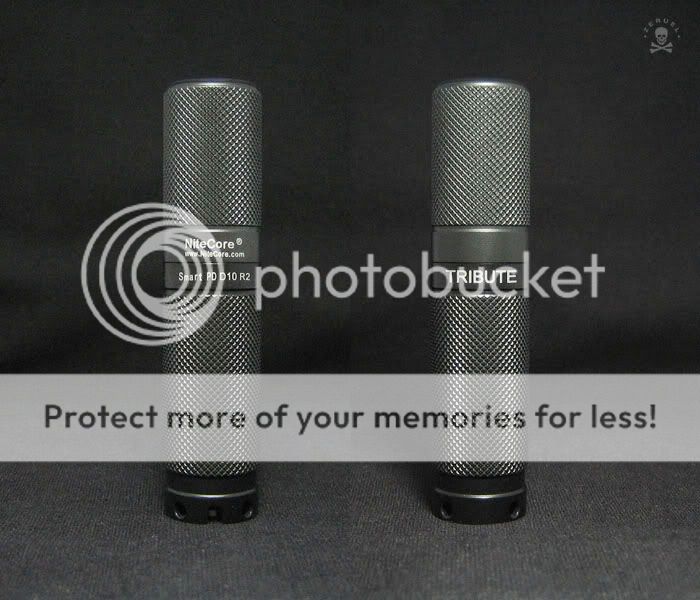
The D10 Tribute comes with 2 bonuses; the nickel-plated clip already installed on the light and a piston with tritium slot (no tritium) for a 2x8mm tritium. :thumbsup:

Another subtle difference is the laser engraving for the "D10 R2" has increased in size.
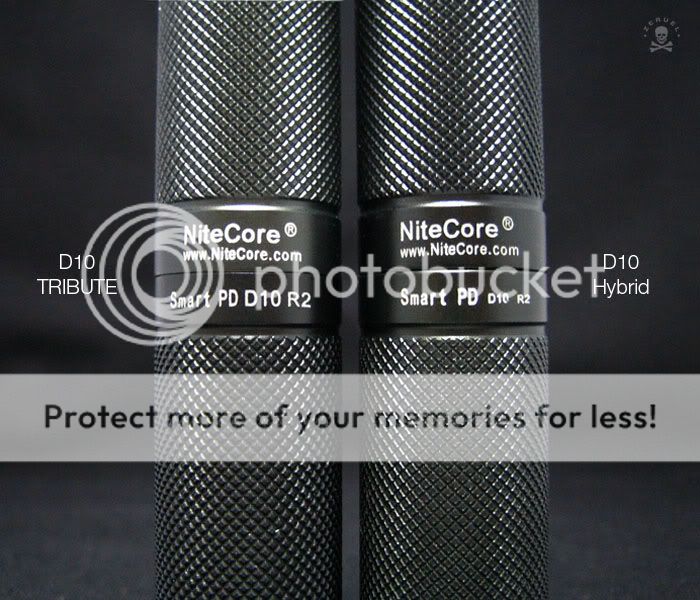
D10 Tribute is available exclusively from Battery Junction (update: sold out). The review sample is kindly contributed by Battery Junction.
Update: Upon purchasing the D10 Tribute after the first batch was sold out, I noticed a production adjustment is made so that the engraved "TRIBUTE" isn't blocked by the clip by positioning it onto the head. The engraving also appears to be more pronounced.

7] D10 SP Warm
There is a substantial number of flashlight enthusiasts who prefer warm or neutral tint of LEDs. To cater to this demand, a batch of D10 is ordered from Nitecore using the warm Q3 (XR-E). The body is marked with D10 SP W. And since it's a SP, it is identical to all SP models with the exception of the emitter used. For a person who prefers the cooler tint, I find the warm tint appealing as it doesn't border on being too sickly warm. As far as I was informed, the Q3 will not be implemented in the ramping version. Available in black only (update: sold out).
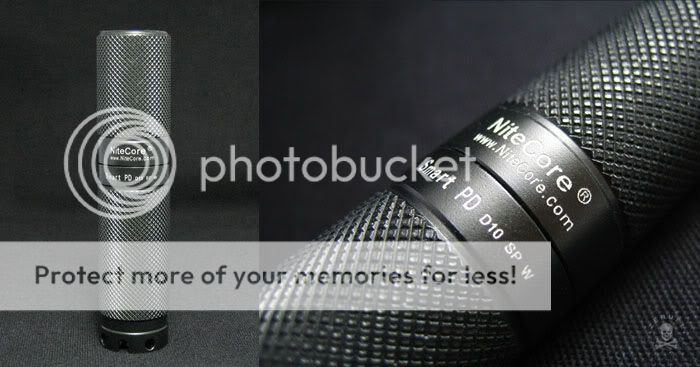
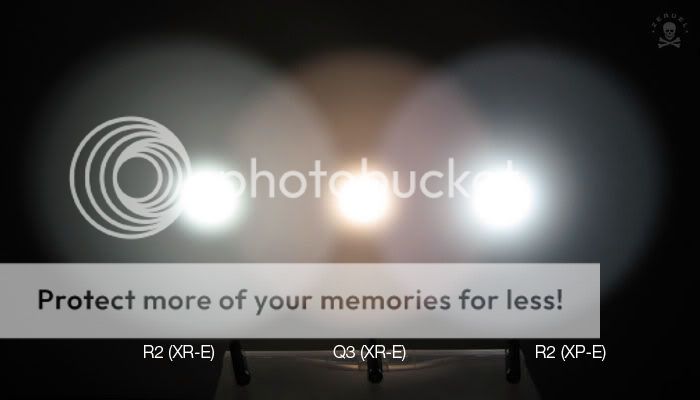
D10 SP W is available from Light Junction.
8] Coated D10s
Cerakote – Samples of D10 with such hard coatings can be found here. The D10s are owned by jslappa.
Black Chrome D10 – A one-off limited release by 4Sevens, this edition was a fast sell-out the week it was launched, IIRC. Image and info contributed by LedTed, the color is deep black with a hint of purple. But the coating, albeit shiny, is not mirror finished.
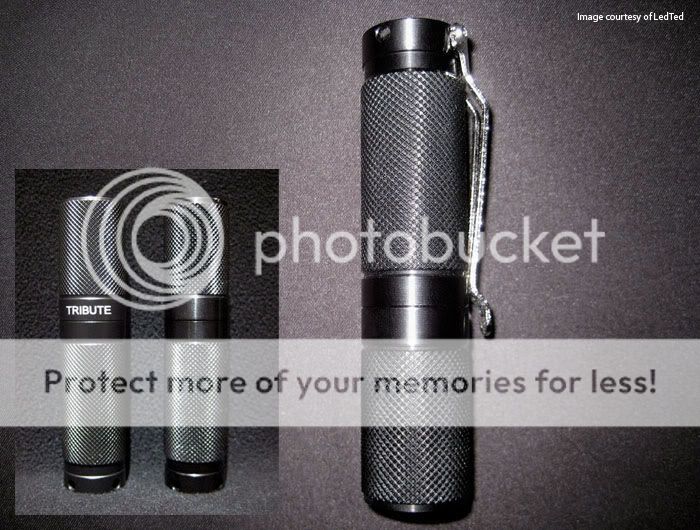
OD Cerakote - I sent a D10 and a D11.2 to Bugsy for cerakoting, this is the nice, matt result.

9] Others
This is a run dedicated to 101st Airborne Division - the Screaming Eagles.
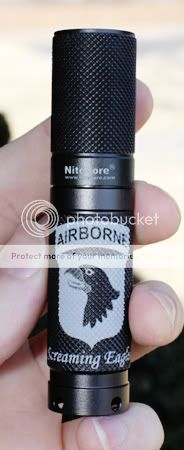
Image Source: Edgetac
---------------------------------------------------------------------------------------------------------------------------------------------------------
BEAMSHOTS
---------------------------------------------------------------------------------------------------------------------------------------------------------
Primary batteries were used for these shots.
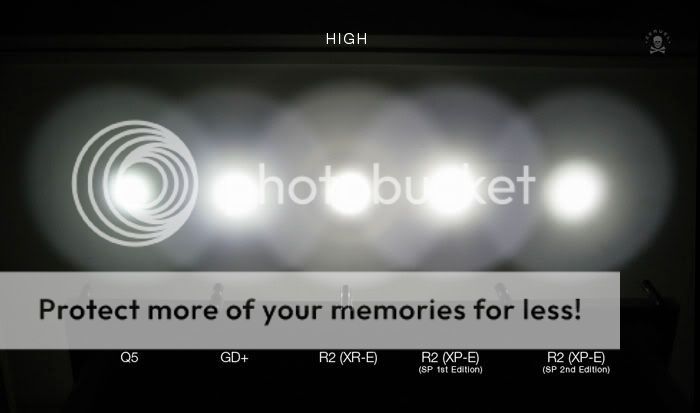
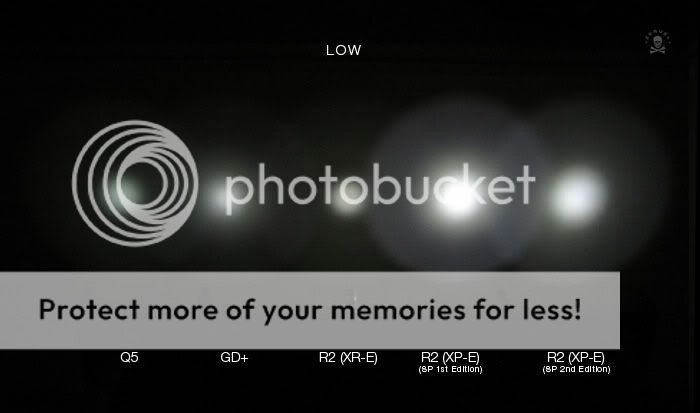
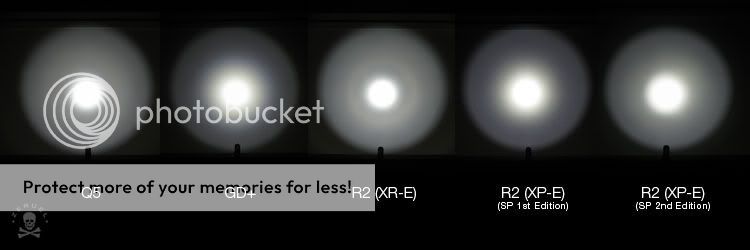
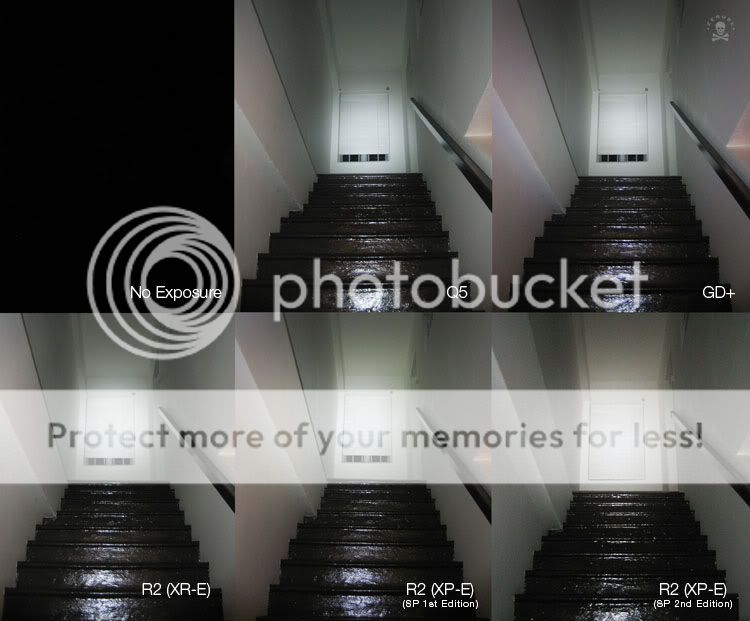
D10 Q5
The whitest beam of the 5 emitters. The beam has minimal artefacts that are extremely faint to the point of unnoticeable unless one scrutinizes it very closely on a white wall. This emitter is for those who prefer the whitest beam with least artefact at the slight sacrifice of output (compare to R2, but it's just only a tad lower).
D10 GD+
The smoothest beam profile of the 5, on par with D10 SP R2 (XP-E) I would say. From the hot spot, it transits to a slightly warm corona and graduates off to a white spill with a tinge of purple. This emitter is for those who prefer the smoothest beam profile at the sacrifice of tint.
D10 R2
The last ramping version and also the brightest (about 10% more than Q5) but with the most Cree rings. A dealer reported majority of the R2 batch has a warmer tint than Q5. This tallied with some owners as well and what's shown here. This emitter is for those who prefer the best throw at the sacrifice of a smooth beam profile.
D10 SP R2 (1st Edition)
This latest version shares very similar traits with GD+ where beam profile is concerned, ie it transits smoothly to a slightly warm corona and graduates off to a white spill with a tinge of purple. But SP has a slightly warmer and purple tints in the graduation compare to GD+. Although the SP is rated to max at 145 lumens similar to R2, but the R2 has a slightly brighter and more defined hotspot but with a downside of CREE rings. On the other hand, the SP has a significant brightest low of the 5 versions. This emitter is for those who prefer a balance between output and smooth beam profile at the sacrifice of tint.
D10 SP R2 (2nd Edition)
I would have thought it will have an identical beam shot as the 1st Edition, however, I see a slightly bigger hotspot that's ring-free and it's a tad warmer than the 1st Edition. In terms of lux, the 1st Edition is visibly higher, meaning it'll have a better throw than the latter.
In a nutshell
Best Throw – Without a doubt, R2 (XR-E).
Best Tint – R2 (XR-E) although this is subjective. But it's has the slightest warmth (consistently throughout) without the minute color cast (green, blue, purple) that comes with other versions.
Best Beam Profile – GD+ is as smooth as a baby's bottom. Close runner-up is R2 (XP-E).
Whitest & Cleanest Beam - Q5. Like snow.
Do note tint lottery exists for some batches.
---------------------------------------------------------------------------------------------------------------------------------------------------------
PACKAGING
---------------------------------------------------------------------------------------------------------------------------------------------------------
Composite for size comparison.
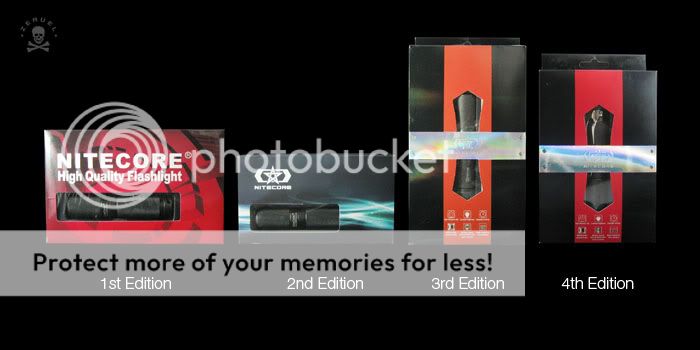
1st Edition
The D10 package comes with a quality paracord lanyard amongst 2 spare o-rings, a warranty card (plastic for Q5 & GD+, paper for R2) and a manual. Color of the lanyard may vary.

2nd Edition
This packaging, which caters for both the older and SP D10s, carries similar accessories to its predecessor with a fold-out for a user guide instead of the previous booklet form. This is the most space efficient size of the three.
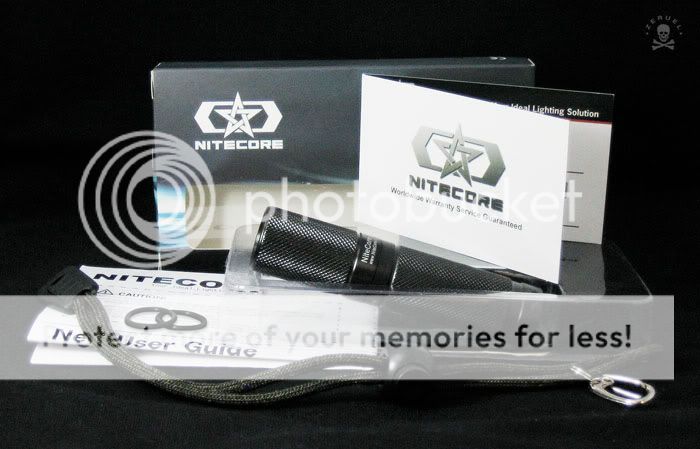
3rd Edition
The D10 SP R2 package has the same set of accessories in a flashier box. It uses paper board tray to hold the light as well as its accessories. While this is more environmentally-friendly, but it does a poor job of holding the light in place and runs into the danger of the light falling out should the buyer pull the tray out facing down.
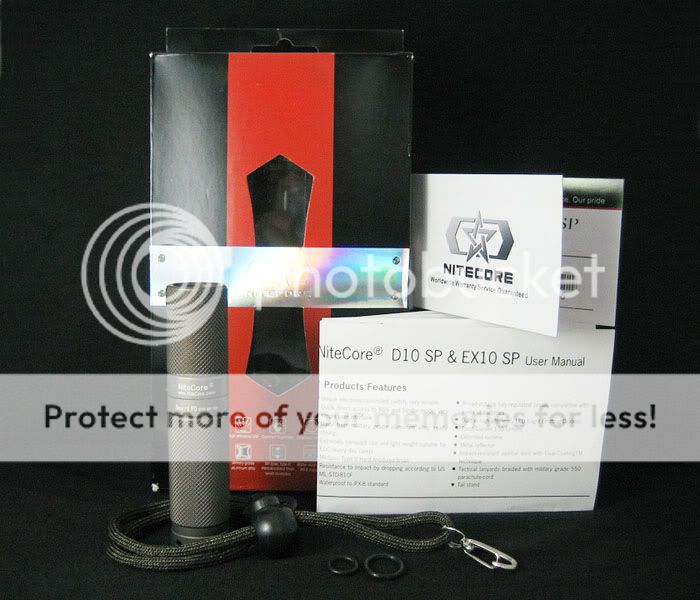
4th Edition
See VERSIONS: D10 Tribute for description.

---------------------------------------------------------------------------------------------------------------------------------------------------------
ACCESSORIES
---------------------------------------------------------------------------------------------------------------------------------------------------------
1] Nickel-plated Clip
2] Titanium Clip
3] Piston with Tritium Slot
4] Headband
5] Red Filter & Wand
6] Tritium Vials
7] Glow-in-the-dark Fobs & Lanyard
8] Other Glow-in-the-dark
9] Holsters
10] Unofficial Lens Cap & Diffuser
1] Nickel-plated Clip
For pocket carry, a nickel-plated clip is sold seperately. The purchase includes the clip with back plate, a hex key and 4 screws for installation. Available at selected CPF dealers or simply Google for more dealers who carry this.

2] Titanium Clip
A full titanium version of the clip. The purchase includes the clip with back plate (both titanium), a hex key and 2 titanium screws for installation. Available from kuku427 (aka Steve) at CPFMP (update: sold out).

3] Piston with Tritium Slot
On the right is the piston with tritium slot to replace the stock piston for both Standard and SP (1st Edition) Editions. This enables a tritium vial of 2 x 8mm (see below) to be installed, thereby allowing the light to be easily located in the dark. Slotted pistons are available from less than a handful CPF dealers and they are usually highly sought after. JHanko also custom-made this in limited titanium runs employing 1.5 x 5mm vials.
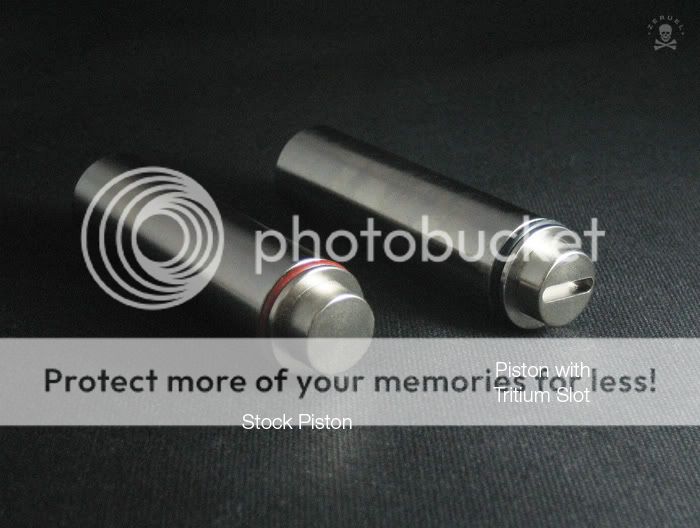
4] Headband
For added versatility, this headband allows free positioning of the light with the choice of 4 separate rings; 2 on top and each on the side. And at the back is a reflective strip for easy spotting, can be an important safety feature especially for night cycling. I would imagine it will be reassuringly bright if 3 x D10s are mounted and activated at the same time, or leaving 2 off just for weight balance and as back-ups. A later updated version is available in blue/yellow. Available from Nitecore authorised dealers.
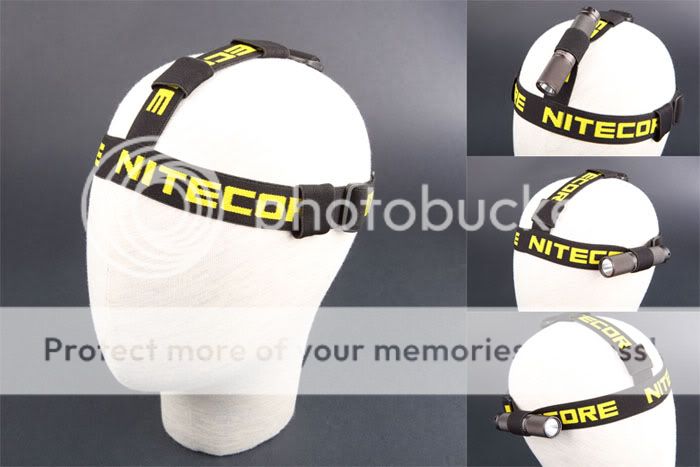
Image Source: Nitecore
5] Red Filter & Wand
This set provides 4 uses; a red filter, a red wand, a white wand and a spare battery holder.
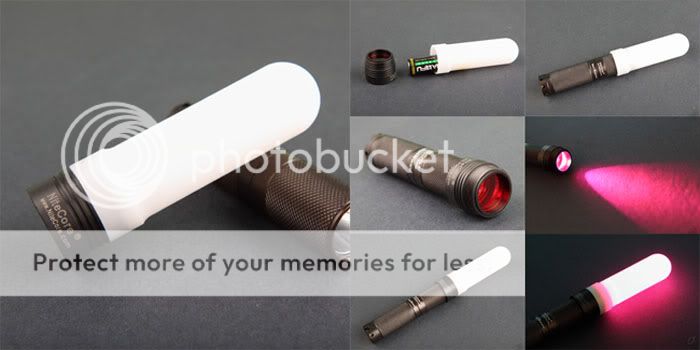
Image Source: Nitecore
6] Tritium Vials
Glow-in-the-dark (GITD) accessories help the user to locate the flashlight in the dark, like in the event of a blackout, groping for the light in the backpack or even searching for the light if it happens to fall to the ground at night. Besides the practical reasons, I have to say it looks cool too.
A tritium vial is a glass vial painted with phosphors and energized by a bit of tritium gas sealed inside, thereby activating a glow. D10 slotted piston takes 2 x 8mm tritium vials with installation via clear epoxy. Tritium vials can be ordered at CPFMarketPlace (CPFMP) under Other Personal Type Lights. Stock and colors will depend on availability.

Here, a modified piston with 2 slots milled to install 2 shorter red tritium vials (1.5mm x 5mm). Modification by Sabrewolf.
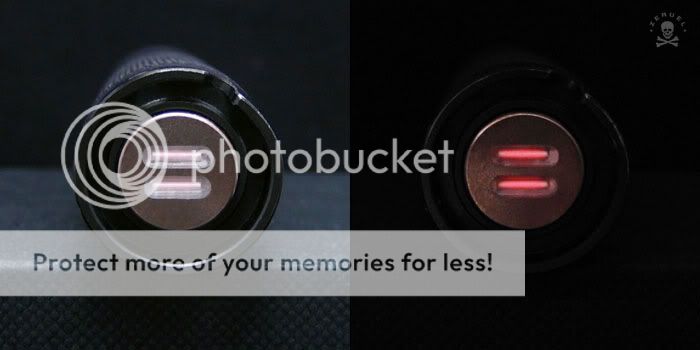
When one sets his imagination and skills to work, glowing wonders can be achieved. Such is the case here where cutting, drilling, milling and polishing give a new perspective to the exciting ways one can display the seemingly suspended vials. Modification by Pugga.
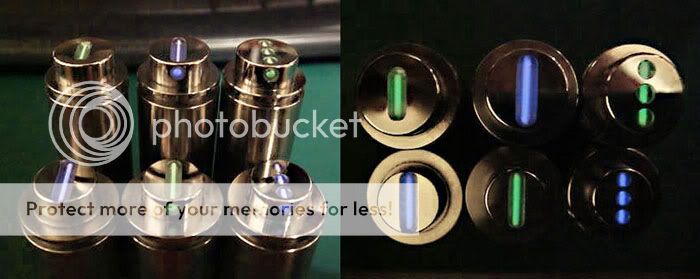
Image courtesy: pugga
7] GITD Fobs & Lanyard
Similarly, you can attach tritium or glow-in-the-dark (GITD) fobs to the light or its lanyard for a similar purpose. The paracord lanyard shown here is custom-made (by Tekno Cowboy). Lanyards (of various length, knots and colors) and GITD fobs can be ordered at CPFMP. Titanium tritium fobs (aka TiGlow) can be ordered at CPF Custom/Mod B/S/T from B@rt and other forms of fob are available at CPFMP. All items depend on availability.
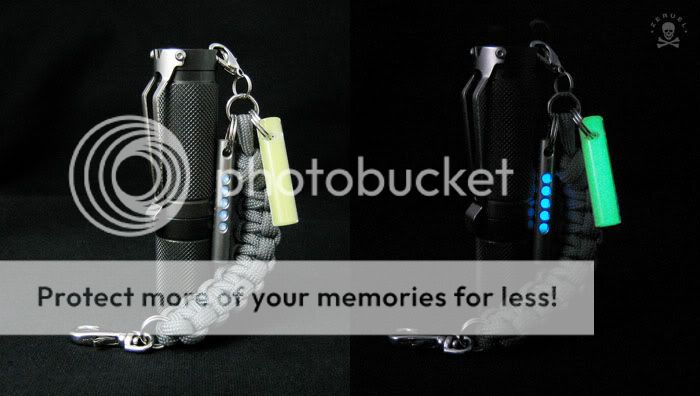
8] Other GITD
Cheapest alternatives are to use GITD o-ring in the tailcap recess (18mm o-ring) or simply adhere GITD tape. GITD tape is sold in a roll at art supplies or DIY stores. O-rings are easily found, notably at CPFMP / WTS: Other Personal from Sigman, Deal Extreme, Lighthound and some DIY stores.
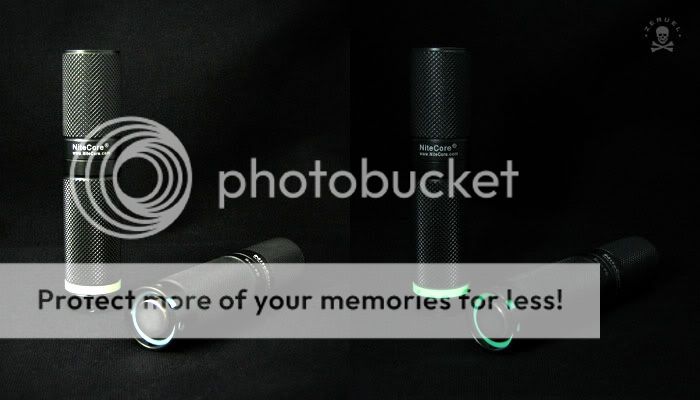
9] Holsters
If you don't wish to pocket carry it, the D10 will fit most holsters meant for single AA lights.
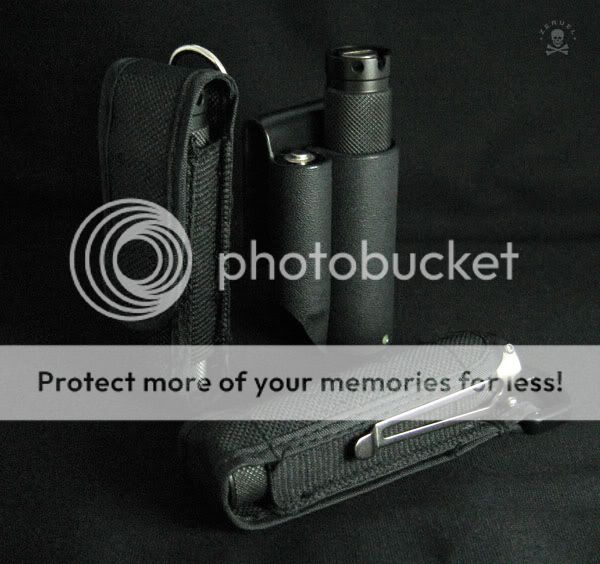
People have asked me about the holster on the right, it's a (dual) kydex holster from LCG Gear (Korea). It was originally holstering a Jetbeam when I got it from CPFMP.
10] Unofficial Lens Cap & Diffuser
Plastic bottle caps can be trimmed to become D10's lens cap and diffuser. Not only does it serve to protect the lens from damage and dirt, its function as a diffuser eliminates hotspot and creates a soft flood. If you can find colored bottle caps, then you have yourself red, green and blue filters (I bet you know which soft drinks to get them from). The inner lining of most standard caps should fit snugly or tightly onto D10's head. If it's loose, just heat the lip slightly and mold the fitting tighter. It's not even cheap, it's free. (source)
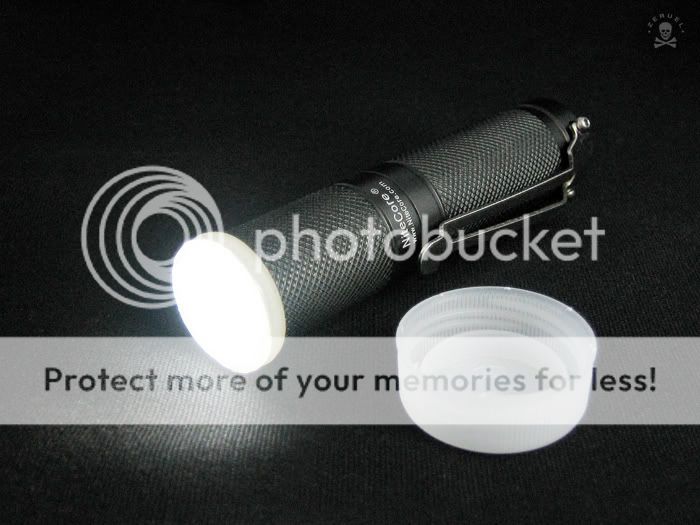
---------------------------------------------------------------------------------------------------------------------------------------------------------
DURABILITY
---------------------------------------------------------------------------------------------------------------------------------------------------------
Here're some amazing videos in which the users have the "pleasure" to abuse D10. These are solid testimonies to the durability and toughness of the light.
Boiling Test
Runover Test
Water-proofing with Activation Test
Drop, Kick & Slam Tests
Dunking Test
The hardy traveling companion testimonial - Climate Test
During it's introductory stage, this was stated by CPFreviews:
This review is a result of more than 150 days of EDC carry. During this period, the flashlights were carried through 2 continents and 6 different locations. Some of the locations were environmental extremes. The flashlights went through temperatures as high as 50° Celsius in the dry desert environment to as low as 6° Celsius winter; with relative humidity of tropical environment in excess of 90% RH to as low as 10% RH in the desert. The flashlights were subjected to sand storms, rain & thunderstorms. NiteCore Smart PD D10 was one of the flashlight that faced all environmental extremes with relative ease. For those, who cant wait to go through full review, rest assured that the Smart PD Design has proven itself to be very reliable if used carefully. NiteCore Smart PD D10 falls in one of the best in its class category.
---------------------------------------------------------------------------------------------------------------------------------------------------------
ISSUES
---------------------------------------------------------------------------------------------------------------------------------------------------------
Like any other brands, Nitecore D10 had its fair share of problems since inception. Rare problems from earlier batch include piston and body fractures and LED flickering etc. All of which were teething problems or occurred in isolated cases. These specific issues were duly addressed with preventive / corrective measures in subsequent batches and should be considered nothing more than footnotes in the pages of the light's history except for rare cases which slipped through QC filtering. If that happens, the user should inform the dealer from which the light came from. If inspection or a repair is needed, it might take some time before the light is returned. This depends if spare parts are lacking or if the light needs to be sent back to the factory. The quickest solution is a replacement, but that is done at the sole discretion (probably at a loss) of the dealer or if the light is beyond repair.
Stiff Switch
A little advice for new purchases. This will be the first thing the buyer notice, the switch has much resistance for activation. This is NOT a switch fault. I assume the factory has generously lubricated the piston and o-ring to ensure maximum protection for storage, taking into account of the unpredictable time the light has to stay on the shelf before it gets sold. To solve the resistance issue, simply remove the piston and wipe it clean, then lightly lubricate the o-ring attached (with nyogel or other non-corrosive lubricant, I find NanoLubes work best) and insert the piston back. It should work smoother now. Some may find the short traverse and non-existant clicky feel a bother, this isn't a problem, it's an inherent feature of the light. Get the SP edition for the longest traverse and if it still a bother, then perhaps D10 is not the choice for you. That said, the new PD system of SP 2nd Edition and Hybrids enables the light to be easy to click out-of-the-box.
Clickity
In few cases, the user might hear clicking or experience erratic mode switching, that would mean the brass contact ring is somewhat stuck. I have not experienced this issue before but the solution is simply to "unstuck" the contact ring by gently pulling it back into position using a pair of tweezers. Similarly, you could also use the tweezer to rotate the ring until it pops right back into place. In the absence of a tweezer, one could use any sharp object small enough to push the tiny gap of the contact ring, this includes the fingernail of your little pinky.
Ramping
Some cited the speed of ramping makes it hard to pinpoint the level the user wishes to select. A test on Q5, GD+ and R2 (no ramping feature for SP) shows ramping down is at a good, stately speed, whereas ramping up is a tad too fast for the R2 and newer Q5 (GD+ perfect). Although this isn't a fault, but I'm hoping the consistency in speed can be uniformed for the next release of Standard Edition.
A "ramping bug" can happen to some older models of D10. It occurs when the light is set at either it's maximum or minimum brightness setting, a short cut to the opposite brightness setting and follow immediately with a press-and-hold for ramping, ramping will not occur unless the pressing is released and press-and-hold again. However, the issue does not occur if the press-and-hold is not activated immediately after the short cut, say give it 3 seconds and it'll ramp as usual.
Battery Drain
There is also the infamous concern; battery drain when off. Such miniscule drainage is essential to keep the light ready to be activated. I did a 7-day drain test with a 1.5v primary battery in D10 R2, battery voltage is measured once every 24 hours.
Battery Drain Report:
Day 1 - 1.449v
Day 2 - 1.446v
Day 3 - 1.442v
Day 4 - 1.440v
Day 5 - 1.437v
Day 6 - 1.436v
Day 7 - 1.434v
Based on the result, it showed a drainage so insignificant, it will take about 420 days for full depletion (if all conditions stay constant). So, any concern in this area is, in my opinion, deem unnecessary. Any full drainage that occurs much lesser than this period would most probably mean the D10 or the battery is faulty.
Accidental Activation
Some users have noted the ease in accidental activation when the light is pocket carried (applies for Standard Editions). This can be simply solved by untwisting the head with half a turn. Even so, accidental activation might still occur if the switch is pushed deep enough (because the light is in momentary switch mode), but it will most likely deactivate immediately as the tension of the battery spring will force it to break contact. Nitecore has answered the call to this problem by introducing a digital lock-out feature in D10 SP.
Emitter Whine
There are a few cases of emitter whining incident. Such whining isn't obvious but to the sensitive or when the light is close enough to the ears. The interesting thing about it is it happens when the battery level is low. This is especially the case when it's at the minimum setting (for Standard Editions). However, I will see this as an plus as it acts as a pseudo-indicator for battery level. For that matter, my SP has whining for low and med levels only which is common for other brands as well.
Reverse Polarity Protection
Reverse polarity protection refers to the design of the circuitry or hardware that prevents a short circuit, in this case, the flashlight's circuitry when the battery is inserted the wrong way in. Because of the lack of this feature in D10, inserting a battery wrongly will fry your light engine almost immediately when you activate the light. The outcome might vary, but mostly involves the noxious smell of the fried circuitry. So, until Nitecore produces a new generation of D10 with reverse polarity protection, one has to practice caution in battery insertion, especially in the dark.
Clip Installation
Although most users have no problem whatsoever, there are a few reports in the difficulty of installing the clip. My first attempt was 3 hours itself. I found the solution to be very simple. Bend the clip head slightly prior to installation. Screw in the pair of screws alternately, make sure the first screw is secured to the thread before going to the next screw. But don't secure the first screw all the way as you need to give the second some leeway to screw in. And lastly, there're 4 screws provided, try the rest if one doesn't work.
---------------------------------------------------------------------------------------------------------------------------------------------------------
MODIFICATION
---------------------------------------------------------------------------------------------------------------------------------------------------------
1] D10 MC-E
2] D10 R5 (XP-G)
3] D10/"D5" CR2
4] D10 with D11V2 Light Engine
A few adventurous CPFers have modified their D10s to their preferences. Most users favor warmer or neutral tints and thus, some (here & here) have done emitter swaps to achieve that. The illumination from such emitters has a warmer tone, thereby enhances the colors of objects and surrounding. The stock emitters, on the other hand, are whiter and slightly brighter in comparison.
Here's a step-by-step procedure for those who wish to do a simple mod or emitter swap. (Note that by doing so, you're voiding the warranty of your light)
(1) With the circuit board facing up, insert one leg of a fine tweezer (or any similar sharp tip) underneath the switch ring, preferably near the gap where it's easier to push.
(2) Gently push the ring away from the circuit board. Take extra caution not to damage any of the chips in the process.
(3) While pushing, lift the ring up. It should be lifted away from the board and proceed to do this gently and slowly in a clockwise manner.
(4) With the ring removed, the rest would be easy. Use needle-nose plier to unscrew the light engine to remove it
(5) Again, use needle-nose plier to remove the reflector and the lens can easily be tapped out.
Here's a step-by-step video.
1] D10 MC-E
And for those who like things a little brighter, here's a working mod; D10 MC-E (warmwhite).

Heatsinking is the greatest consideration for such a venture, to the point of being an "impractical" modification. However, it isn't possible to expand the heatsink without compromising the stock size or light engine. Nonetheless, the result is surprising. Using a God-given hi-tec equipment like my hand, I had the light set on maximum in room temperature. The hand meter measures heat ranging cool > warm > hot > untouchable.
1 - 5 mins = cool
6 - 10 mins = warm
11 - 20mins = warm
21 - 30mins = warm
31 - 40mins = warm
41 - 50mins = warm
51 - 60mins = warm
I stopped at 1 hour. Impressive, it seems as if even the heatsinking is regulated, but then again, I'm sure the real reason is because the LED is under-driven. Having said that, it's still a bright flood (more than R2 naturally) albeit the usual quad-die donut beam on white wall. A point to highlight is ramping with MC-E works without a hitch, hence brightness, runtime and heat can be "controlled" by ramping down to a lower output. Hence now, the "impractical" has become the possible. MC-E modification was done by Sabrewolf.
Beam Shots
A "donut" or "crosshair" beam is common for lights using quad die emitters such as MC-E or SSC P7, especially when used close-up indoors.
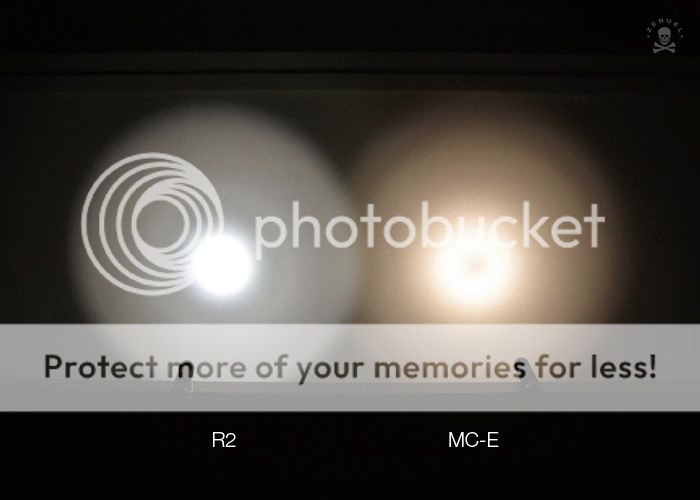
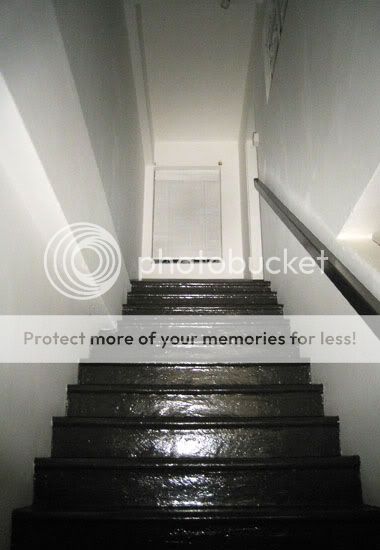
2] D10 R5 (XP-G)
I've swapped a D10's Q5 with the latest CREE R5 on a 10mm board. The emitter is pretty small set against the original reflector meant for a Q5, nonetheless, it still works on all levels.
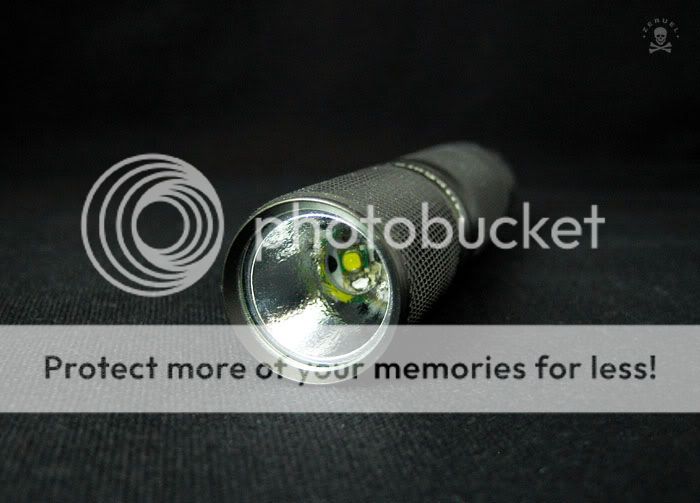
Beam Shots
Generally, the R5 projects a pretty smooth profile, giving it lesser throw but a bigger hotspot and spill. As shown, it also has a slight greenish cast (typical of R5) to it with a very smooth transition from hotspot to corona to spill, almost as buttery smooth as R2 (XP-E). Below is a comparison between R5 (XP-G) and R2 (XR-E). R2 (XR-2) is still the clear winner for throw.


3] D10/"D5" CR2
This project is initiated by ma-sha1 in hope to create, perhaps the world's smallest piston drive light. This is done by modding D10 to take in C2. It made me realized the diameter of a CR2 battery is almost similar to an AA. And it also certainly realized the desire of carrying a D10 on a keychain (although some may find it a tad thicker than AAA lights). It is very difficult to find a CR2 that's a clicky, let alone having one that provides the benefits of a piston drive. With the availability of ramping or 3-modes, strobe, digital lock-out and a long runtime on low, it'll almost make a perfect back-up on keychain or as a spare in bag. (source)
4] D10 with D11V2 Light Engine
D11 and D11V2 have been released for some time now. In comparison, Nitecore has made some definite improvements like a thicker body, a deeper switch traverse, additional modes, switch lock-out system, a more efficient emitter and flat sides for anti-roll (albeit rather ineffective if you ask me). And somewhat importantly, I suspect Nitecore has taken our "suggestions" into consideration and decided to throw shortcuts to high and low back into the light that is now the D11V2.
Call me old school, but I still find D10 to be classier and more appealing. Perhaps it's the simple but effective form of the knurled tube without any grooves and awkward anti-roll feature. Or perhaps it's the original one that I really like and has been using hard. Or perhaps because that I would really like to use an EDC with a clip. Or perhaps I just want some mesmerizing trits on the pistol switch. Well, probably all of the above.
But I must say I would prefer the light engine of D11V2 now that it has a brighter R5 XP-G with hidden blinky modes and digital lock-out. So I would have me the best of both worlds by replacing the guts of D10 with D11V2's. I'm using a spare D10 titanium shell for this which is identical to stock D10s if you wish to do the same operation.
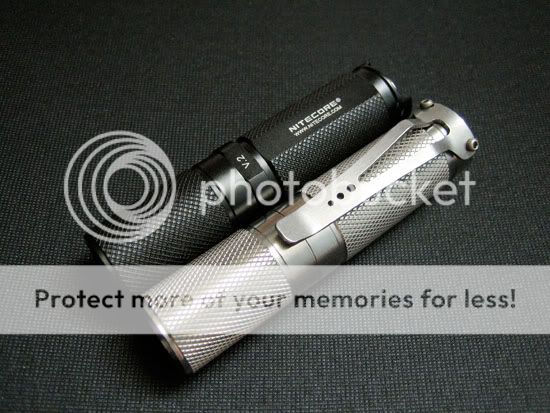
D11V2 and an empty titanium host
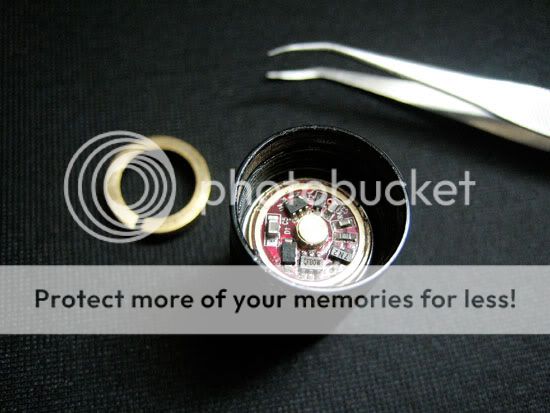
The most difficult process is the removal of the brass ring. Great care needs to be taken not to damage the chips.
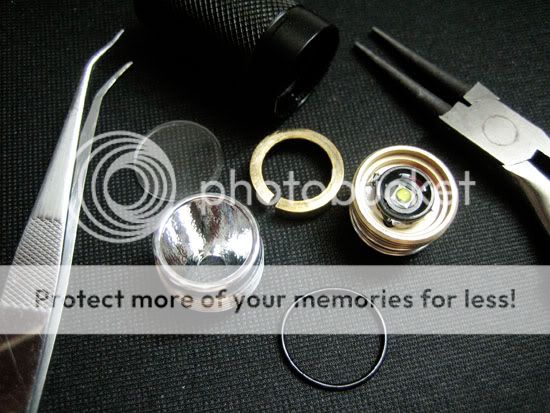
After the brass ring is removed, all else can be easily screwed out. Congratulations, your warranty is now void. Note that the brass ring must be formed back to shape if it's distorted during removal or there'll be difficulties in ring operation later on.

Reverse the process when installing the guts into D10. Ta-dah.
---------------------------------------------------------------------------------------------------------------------------------------------------------
IMAGES
---------------------------------------------------------------------------------------------------------------------------------------------------------
Feast your eyes on a multitude of pictures contributed by D10 owners.
---------------------------------------------------------------------------------------------------------------------------------------------------------
CONCLUSION
---------------------------------------------------------------------------------------------------------------------------------------------------------
I'm not saying D10 is for everyone, but with the price point and what it can offer, it is an AA light to be reckoned with and is worthy of consideration for those who wants an entry light. Love it or hate it, as far as I see, it's a matter of the user getting past the initial oddity of the PD function.
It came as a surprise and much to CPF users' disappointment when Nitecore discontinued the standard ramping user interface of the original D10. By itself, I can't say the SP is that bad, but it has certainly lost the familiar workings of the original that I've grown attached to. Personally, I would prefer a hybrid of the two*; Ramping user interface with hidden strobe activation and the digital lock-out. As mentioned, reverse polarity protection should have been included as well but didn't. Only time will tell if I can get use to SP and any possible newer versions. But since there are still original versions floating in the market, options are available for buyers.... at the moment.
Hopefully soon, the next batch involves an emitter update with XP-G R5 or even S2. It would be nice if Nitecore expand the D10 range to include different finishings (Olive Drab, Red, Gray etc) and materials (Titanium, Stainless Steel, Chrome etc). As though reading my mind, Nitecore recently released new D10s with Light Natural, Dark Brown and Camo options after I penned this.
Unless Nitecore steamlined D10s down to EZ AA size (which I hope though unlikely), I don't foresee a significant overhaul with a new hardware design. Then again, like the discontinued UI, you'll never know. But I do hope they will continue to uphold the quality and user-friendliness in their new releases, in the same class as D10, which has successfully crystalized efficiency in form and function, a testimony supported by its popularity long after its inception.
*NiteCore did eventually release D11 and D11v2 that employ a hybrid of the two.

When I first joined CPF, like many, I sought for the first entry level edc to start on this path of no return. I wanted something handy, compact, affordable, easy-to-use, takes in universal AA, bright and definitely not the least, looks good. Seemed like a tall order, but I found Nitecore D10. That began my journey in exploring this innovation by Nitecore (established by Edgetac) & 4Sevens, and I ended up having a good time researching and reading up a wealth of information on this light.
It is exactly one year after I registered as a CPF member and all these while, like a boy in a candy store, I have eagerly bought and played with many lights. Some came and stayed and most sold to fund for newer and better stuff. But the D10 has stayed from day one, which I have come to depend on as an edc, a backup, a backup's backup, a backup's backup's backup, well, you know the drill. Should it come to pass I am to choose one and let the rest go (stock lights), I'll pick D10. Why do I like it so?
---------------------------------------------------------------------------------------------------------------------------------------------------------
ADVANTAGES
---------------------------------------------------------------------------------------------------------------------------------------------------------
Based on my user experience, Nitecore D10 has the best balance of all features. It may not be the brightest (although it's still one of the brightest AA lights today), but it makes up through efficiency. It is not the smallest, so that it's at the right size to be grasped by my hand. It is not the most expensive, so it will not be a shelf queen. It is not rare, so that we can have more of it.
The qualities I treasure in D10 are many. I shan't go into the technical details for I defer to the experts here who have done a far greater job in sharing their reviews (links below). So, as a user who is technically challenged (numbers scare me), my reasons are thus...
On top of being my first edc (you remember your first love, don't ya), I always have a weakness for tubular form. That began with my earlier purchases besides D10; Maglite Solitaire, the Fenix L2P and Jetbeam E3P. There's always something appealing about the simple beauty of a tube and I'm glad D10 didn't go beyond that other than adding some very good knurling for a reassuring grip.
Also, D10 can be used as a twisty or a "clicky", both ways allow one-hand operation to control activation. One of the key features of D10 is that it employs the Smart Piston Drive (PD) System, a wonderful brainchild of McGizmo; the PD is a piston within the light body that houses the battery and depressing the switch (top part of the piston protruding out of the tail end) will activate the light through the switching mechanism in the head.

When I first received the D10, I wasn't accustomed to the PD system because, unlike the traditional clicky, it has a short traverse and doesn't resonate with a reassuring "click" to affirm activation. But very shortly after, I got used to it and grew to like this silent PD feature. In fact, it became my default light for that flashaholic's clicking fetish.
In the absence of a traditional clicky switch, there are lesser parts to wear off and take care of. And naturally, I would think a metal switch would outlast a rubber boot (boot refers to the rubber cap of a switch) in extreme circumstances like fire, corrosive liquid spill, scraps, cuts etc. The flat tail end of D10 provides candle mode (tail-standing) capability, something I find essential for indoor usage. The PD also enhances switch reliability and reputed to be safe for activation in a flammable environment due to this electronic switching method.
The light uses the ubiquitous AA battery of any kind, namely primary, alkaline, Nimh or Li-ion so there's no fear in finding spare batteries for this light virtually in any part of the world (unless you're lost in the woods). With a primary AA, the light can run up to an impressive 45 - 100 hours on minimum setting, depending on the D10 model. And it does notably run brighter (up to R2 XR-E) on rechargeable Li-ion than the rest (source) but take note of the minute size differences of different Li-ion brands, some are longer than others which might disable the function of the PD. On my end, I have no trouble using AW 14500. And also in the latest versions, running D10 on NiMH and Li-ion will not show much of a difference in output (approximately a difference of 8 lumens only).
This compact light can withstand lots of abuse, more abuse that I would have imagined when I bought it. You can view the video links below to attest to this. It's aggressive diamond-textured knurling maximizes grip and has an almost therapeutic effect to hold it in your hand. Needless to say, it also provides good grip to use the light as a twisty and unscrewing the body for battery replacement, such is a piece of cake for handling even for greasy or sweaty hands. However, the D10s in my possession show the knurling has lost a tad of bite in the later R2 version compared to the earlier Q5 and Golden Dragon Plus counterparts but seemed to revive the bite in the latest SP R2 version.
Last but not least are the many fine details that went into the construction of the light to ensure overall build quality. To name a few, solid aluminum reflector (tougher and better heatsink), diamond double-coated lens (impact resistant with anti-reflective), gold-plated battery contact spring (better conductivity) and solid brass contact ring (solidity and conductivity).
---------------------------------------------------------------------------------------------------------------------------------------------------------
USER INTERFACE
---------------------------------------------------------------------------------------------------------------------------------------------------------
D10 (R2 and earlier)
The benefits of the PD system are many. By means of the micro processor in the head, the light output can by programmed by ramping to any value between 3 to 145 lumens, a low low, a bright bright and any level in-between. Function-wise, D10 gives you quick direct access to minimum or maximum output; Double click to get lowest, click and hold to get highest, or just hold down to ramp up or down to choose a brightness level (Infinitely Variable Digital-controlled Brightness System). Its memory mode enables the light to retain the last output setting. Pretty much a simple and easy-to-use interface. And there's no strobe and SOS mode to irritate the heck out of me. By untwisting the head simply by half a turn, it allows the PD to be used as a momentary switch. This also acts as a deterrent measure against accidental activation.
Here's an explanatory video on the workings of the PD system (Ramping Versions). And further discussion of the system can be read here.
D10 SP (R2)
The latest D10 SP R2 has deviated from the UI of the standard version to offer a further simplified UI and strobe/SOS to those who wished for it. It's updated with a XP-E R2 and a slightly more dimpled reflector, thereby enabling a buttery smooth beam profile.
Besides using XP-E R2 emitters, it has replaced the ramping feature with a 3 pre-set outputs of 2 lumens (100 hours), 35 lumens (6 hours) and 130 lumens (1 hour). Compare that to D10 R2 which outputs 3 lumens (45 hours) to 145 lumens (50 minutes), I'd say there's a surprising improvement, ie twice the runtime on low mode!
It also seems there were requests for SOS/Strobe which is now incorporated into D10 SP. Much to my relief, this feature is hidden, meaning the user doesn't need to cycle through SOS/Strobe modes to get to the regular output setting. I also applaud the implementation of the digital lock-out feature which prevents accidental activation.
I am surprised by the introduction of D10 SP, given that SOS/Strobe is generally not a popular feature (as far as I see) and the most unique part of the light, the ramping capability, to be replaced with 3 pre-set levels. However, the SP Edition does fill the need for some who wants simplicity and such strobe features. I certainly welcome the digital lock-out function and the buttery smooth beam profile of the XP-E R2. I'm glad to to have given SP the benefit of the doubt by trying it out. It turned out not too bad, contradicting my initial judgement.
Here's basically how the features work:
When light is on, press and hold to cycle through min, med and max to choose level. This step-up switching occurs less than a second, a good speed that enables accurate mode selection and also not too slow for cycling for the next loop. This mode selection can also be done when the bezel is loosen to enable momentary-on mode. However, even if it's termed as momentary-on, loosening the bezel only allows mode selection, the light cannot be used momentary-on because mode switching will activate in less than a second.
While the light is on, double-click to enter SOS or click and hold (1 click and hold down on the second click) to enter strobe mode. For my SP, the speed of the SOS seems odd. It goes through a cycle of 3 SOS. It starts off with a fast SOS, a slow SOS and then a fast SOS. The cycle then loops.
To avoid accidental activation, simply press and hold while the light is off. A short flash will indicate safety lock-out mode is enabled. Triple click the tail cap to activate the light again. I think this is the best new feature to be implemented.
---------------------------------------------------------------------------------------------------------------------------------------------------------
REVIEWS
---------------------------------------------------------------------------------------------------------------------------------------------------------
Here're some in-depth reviews consisting runtimes, readings, part-by-part descriptions and opinions by the reviewers I mentioned earlier.
Selfbuilt's Reviews:
D10 SP
D10 GD+
D10 Q5
Unknown's Review:
D10 Q5
CPFreviews:
D10 Q5
Mini Review of D10 SP
There're 2 version of SP so far. For simplicity, I'll name them 1st and 2nd Editions. The 1st Edition has the same hardware as the ramping R2, the only physical difference as far as I can tell, is the marking on the head and the color of the circuit board.
Whereas for the 2nd Edition SP, the distinct physical change is the relocation of the piston o-ring and the recess in which this o-ring operates. The new position of the o-ring is supposedly to make activation easier compare to the previous versions with which users found it stiffer to depress. By comparing the activation between the old and new pistons, I feel no difference in the ease of activation. However, I did clean and lubricate the older pistons before using. The ease of activation from the new SP is evident out-of-the-box. However, doing a double click to get SOS and a click & hold to get Strobe require slightly more effort now because of a longer traverse and a sluggish reaction from the o-ring.
In terms of waterproofing, I believe there's an improvement over the older models. There is a what appears to be a 0.5mm gap between the piston button and the body for the previous D10 and this might allow smaller particles like fine sand to enter and settle in the space between the o-ring and the entry point. For the new piston system, the gap is almost negligible and with the o-ring higher up, chances of dirt and water residue remaining in the tail portion is minimized.
The 2nd Edition SP comes in 3 finishing; Camo, Dark Brown and Light Natural. For this thread, I've included the Light Natural version. Below are some images showing the physical differences of the old and new.

Camo, Light Natural & Dark Brown (never released)


Taller recess for the new o-ring position
---------------------------------------------------------------------------------------------------------------------------------------------------------
VERSIONS
---------------------------------------------------------------------------------------------------------------------------------------------------------
Here is a compiled list of all D10s from the past to the present, from the mass to the very limited.
1] Stock D10s
2] Hybrid D10s
3] Special Anodized D10s
4] Custom-made Titanium D10
5] Limited Edition Titanium D10
6] D10 Tribute Edition
7] D10 SP Warm
8] Exotic Coated D10
9] Others
1] Stock D10s
These D10s are mass produced for the market and it started with the Q5 till today's R2 (XP-E). There is some confusion created by the newest because of custom-order by the Hong Kong distributor. This involved intermixing new hardware with previous software (which is more popular), but these "hybrids" are not mass-produced.
In order of release for stock D10s:
Q5 – Black. Ramping UI.
GD+ – Black. Ramping UI.
R2 (XR-E) – Black. Ramping UI.
SP R2 1st Edition (XP-E) – Black. New UI.
SP R2 2nd Edition (XP-E) - Light Natural, Camouflage & Dark Brown (never got released AFAIK). Revised PD system and New UI.
Ramping = Infinitely Variable Digital-controlled Brightness System
Hybrid refers to new PD system (hardware) with original ramping user interface.
Emitters Q5, R2 (XR-E) and R2 (XP-E) are from LED manufacturer CREE.
Golden Dragon Plus is from OSRAM.
In terms of mass-produced D10s to date, there're 5 versions differentiated mainly by their emitters; Q5, Golden Dragon Plus (GD+), R2 (XR-E) and 2 versions of SP R2 (XP-E).


D10 Q5
The introductory D10 uses the Q5 emitter. The original version has an inscription of "D10" on the head but the inscription has dropped down to the body section in later batches. The first batch of D10 has a very thin bezel rim which I have my doubt if it would survive a drop head on, so as to speak. This was later improved with thicker rims for subsequent batches till today. Type 3 hard anodizing appears very dark grey and has a very good grip provided by the aggressive knurling. This version has phased out and is discontinued, but are still available from less than a handful of dealers.
D10 Osram Golden Dragon Plus (GD+)
Body is similar to Q5's in terms of color and knurling. No markings of any sort to show it's GD+, just Smart PD D10. The most limited run of the 4, this version has phased out and is discontiunued. Once in a while, It might be available through WTS section in CPFMP.
D10 R2 (XR-E)
The latest regular version to date. The body of the R2 has thickened by 0.5mm to further strengthen the wall. That's a good consideration from Nitecore, but I found out it no longer fit into kydex holsters as easily as the former versions although soft holsters using nylon and leather are not a problem. Anodizing for earlier R2 batches appears black and knurling seems to have lesser grip than its predecessors. The later batches seemed to have reverted to knurling similar to Q5. The light has a R2 marking on the body. Leftover stock available from some Nitecore dealers although it's discontinued.
D10 SP R2 (XP-E) 1st Edition
This is marked with D10 SP R2. It has a somewhat rounder lip of the head and the knurling is similar to the aggressive texture of Q5's. The color of anodizing is closer to black than grey, but then this might differ from batch to batch. The traverse to activate the switch is the longest amongst all versions, seems like a modification is made to the switch ring to do that (furthest distance from the circuit board). D10 SP and later batches of D10 R2 have similar body characteristics. Stock available from some Nitecore dealers.
D10 SP R2 (XP-E) 2nd Edition
Physically similar to 1st Edition with the exception of using a new PD system and 3 anodizing options. Stock available from some Nitecore dealers (depending if the stock has been updated).
2]Hybrid D10s
These are customized limited runs requested by the distributor in Hong Kong. All hardware (including emitter & reflector), anodizing and packaging are identical to SP except for the UI, which uses the original ramping interface and this presents a best-of-both-worlds option for those who prefer ramping. Identify a hybrid by its marking (it should just read D10 R2), new piston o-ring position and a red circuit board (which is almost similar to SP's). This version comes in XP-E and XR-E. Since it's using identical emitter and reflector, the beam profile is similar to SP, but tint lottery is evident for both of my XP-Es where I have one slightly warmer than the other.
R2 Hybrid (XR-E & XP-E) - Black & Light Natural. Revised PD system with Ramping UI.
Note that terms like "1st, 2nd Editions & Hybrid" are stated by me for simplicity and they are not official terms used by Nitecore or its dealers.


Available in Light Natural & Black only.

3] Special Anodized D10 by Swissbianco (Limited Edition)
This series of Limited Edition D10s are available with Q5 emitters employing first batch's body. Only 25 of each design are produced and they're serialized. Available from 4Sevens and selected CPF dealers (update: sold out). Anodizing was done by Swissbianco.


4] Titanium D10 by JHanko (Custom-made)
These are magnificent titanium versions of the light, pieces that D10, titanium and even tritium lovers would drool over. These titanium hosts are created by, what I would consider, a master at what he does. They are considered to be the holy grail of D10s, underlined by the rarity of AA titanium lights available. Shown here is the latest development employing "3D Tritiums", a smart innovation that later inspired many others. The convenient aspect of a titanium D10 is it uses the light engine from any stock D10, hence it can conveniently be replaced for fault remedy or for upgrades. If you get enough stock D10s (specifically the engines) and with one of these grails, you could literally use the light for a long time and maybe someday, hand it down to your kids.


Titanium D10s are designed and produced by Jhanko (aka Jeff). A great thanks to Jeff for the Ti D10 with ice blue trits.
5] Titanium D10 by kuku427 (Limited Edition)
This titanium D10 has identical design as the stock version. So far, only 10 are produced for this short run, each set includes the head, body and the tritium-slotted (1.5 x 5mm vial) piston. Due to popular demand, another set of titanium D10 was produced at a later stage. The only different between the first and second batches are the number of tritium slots on the piston; first batch has one whereas second batch has two. A beneficial difference from the stock is that it uses square threading for added strength. Likewise, it can take in light engine from any stock D10, including the latest SP.

Dealer for Titanium D10s is kuku427 (aka Steve).
6] D10 Tribute Edition by Battery Junction
This D10 is initiated by Matt (Battery Junction) as a Tribute light in tribute to this tribute thread. :laughing: To be precise, this is a D10 Hybrid with TRIBUTE laser engraved on it. Meaning it's using the new PD system, has a ramping UI, similar LED (R2 XP-E) & reflector and an identical smooth beam (see D10 SP R2 XP-E) to the Hybrid. Again, I find the initial ramping up a tad too fast, which is not as gradual as ramping down. But I think I'm just nitpicking.
On top of being a limited edition (400 pieces in 2 separate batches of 200), like the Hybrid, it offers a best-of-both-worlds scenario for users who prefer the ramping UI encased in the new piston drive system. However, there're a few physical differences in this special package as shown in the following...
Once again, Nitecore has revised their packaging. I believe this is the 4th version (see "PACKAGING" for size comparison) for latest D10 in general and it's not for D10 Tribute per se since there's no printing indication to show this new packaging is exclusively for the Tribute. It has become shorter than the previous one, which I'm glad for as it's less cumbersome and better use of space. The vermillion (orangy red) band is now red. What was previously an internal paper tray is now a plastic-molded tray with a sponge inlet to cradle the light. I guess the reason for this change is the paper version distorts easily during packaging and transportation, causing the light within to be displayed off-side and it also doesn't really hold the light well. My Tribute package doesn't come with spare o-rings and lanyard, but IMO this is compensated by extra bonuses mentioned below.

Obviously, "TRIBUTE" is boldly laser-engraved on its body. I removed the clip to show it in its full glory. My sample has a slight anodizing discrepancy, head is dark gray and body is black. So I guess some buyers will get grey ones, some black ones and some others will get 2 tones.

The D10 Tribute comes with 2 bonuses; the nickel-plated clip already installed on the light and a piston with tritium slot (no tritium) for a 2x8mm tritium. :thumbsup:

Another subtle difference is the laser engraving for the "D10 R2" has increased in size.

D10 Tribute is available exclusively from Battery Junction (update: sold out). The review sample is kindly contributed by Battery Junction.
Update: Upon purchasing the D10 Tribute after the first batch was sold out, I noticed a production adjustment is made so that the engraved "TRIBUTE" isn't blocked by the clip by positioning it onto the head. The engraving also appears to be more pronounced.

7] D10 SP Warm
There is a substantial number of flashlight enthusiasts who prefer warm or neutral tint of LEDs. To cater to this demand, a batch of D10 is ordered from Nitecore using the warm Q3 (XR-E). The body is marked with D10 SP W. And since it's a SP, it is identical to all SP models with the exception of the emitter used. For a person who prefers the cooler tint, I find the warm tint appealing as it doesn't border on being too sickly warm. As far as I was informed, the Q3 will not be implemented in the ramping version. Available in black only (update: sold out).


D10 SP W is available from Light Junction.
8] Coated D10s
Cerakote – Samples of D10 with such hard coatings can be found here. The D10s are owned by jslappa.
Black Chrome D10 – A one-off limited release by 4Sevens, this edition was a fast sell-out the week it was launched, IIRC. Image and info contributed by LedTed, the color is deep black with a hint of purple. But the coating, albeit shiny, is not mirror finished.

OD Cerakote - I sent a D10 and a D11.2 to Bugsy for cerakoting, this is the nice, matt result.

9] Others
This is a run dedicated to 101st Airborne Division - the Screaming Eagles.

Image Source: Edgetac
---------------------------------------------------------------------------------------------------------------------------------------------------------
BEAMSHOTS
---------------------------------------------------------------------------------------------------------------------------------------------------------
Primary batteries were used for these shots.




D10 Q5
The whitest beam of the 5 emitters. The beam has minimal artefacts that are extremely faint to the point of unnoticeable unless one scrutinizes it very closely on a white wall. This emitter is for those who prefer the whitest beam with least artefact at the slight sacrifice of output (compare to R2, but it's just only a tad lower).
D10 GD+
The smoothest beam profile of the 5, on par with D10 SP R2 (XP-E) I would say. From the hot spot, it transits to a slightly warm corona and graduates off to a white spill with a tinge of purple. This emitter is for those who prefer the smoothest beam profile at the sacrifice of tint.
D10 R2
The last ramping version and also the brightest (about 10% more than Q5) but with the most Cree rings. A dealer reported majority of the R2 batch has a warmer tint than Q5. This tallied with some owners as well and what's shown here. This emitter is for those who prefer the best throw at the sacrifice of a smooth beam profile.
D10 SP R2 (1st Edition)
This latest version shares very similar traits with GD+ where beam profile is concerned, ie it transits smoothly to a slightly warm corona and graduates off to a white spill with a tinge of purple. But SP has a slightly warmer and purple tints in the graduation compare to GD+. Although the SP is rated to max at 145 lumens similar to R2, but the R2 has a slightly brighter and more defined hotspot but with a downside of CREE rings. On the other hand, the SP has a significant brightest low of the 5 versions. This emitter is for those who prefer a balance between output and smooth beam profile at the sacrifice of tint.
D10 SP R2 (2nd Edition)
I would have thought it will have an identical beam shot as the 1st Edition, however, I see a slightly bigger hotspot that's ring-free and it's a tad warmer than the 1st Edition. In terms of lux, the 1st Edition is visibly higher, meaning it'll have a better throw than the latter.
In a nutshell
Best Throw – Without a doubt, R2 (XR-E).
Best Tint – R2 (XR-E) although this is subjective. But it's has the slightest warmth (consistently throughout) without the minute color cast (green, blue, purple) that comes with other versions.
Best Beam Profile – GD+ is as smooth as a baby's bottom. Close runner-up is R2 (XP-E).
Whitest & Cleanest Beam - Q5. Like snow.
Do note tint lottery exists for some batches.
---------------------------------------------------------------------------------------------------------------------------------------------------------
PACKAGING
---------------------------------------------------------------------------------------------------------------------------------------------------------
Composite for size comparison.

1st Edition
The D10 package comes with a quality paracord lanyard amongst 2 spare o-rings, a warranty card (plastic for Q5 & GD+, paper for R2) and a manual. Color of the lanyard may vary.

2nd Edition
This packaging, which caters for both the older and SP D10s, carries similar accessories to its predecessor with a fold-out for a user guide instead of the previous booklet form. This is the most space efficient size of the three.

3rd Edition
The D10 SP R2 package has the same set of accessories in a flashier box. It uses paper board tray to hold the light as well as its accessories. While this is more environmentally-friendly, but it does a poor job of holding the light in place and runs into the danger of the light falling out should the buyer pull the tray out facing down.

4th Edition
See VERSIONS: D10 Tribute for description.

---------------------------------------------------------------------------------------------------------------------------------------------------------
ACCESSORIES
---------------------------------------------------------------------------------------------------------------------------------------------------------
1] Nickel-plated Clip
2] Titanium Clip
3] Piston with Tritium Slot
4] Headband
5] Red Filter & Wand
6] Tritium Vials
7] Glow-in-the-dark Fobs & Lanyard
8] Other Glow-in-the-dark
9] Holsters
10] Unofficial Lens Cap & Diffuser
1] Nickel-plated Clip
For pocket carry, a nickel-plated clip is sold seperately. The purchase includes the clip with back plate, a hex key and 4 screws for installation. Available at selected CPF dealers or simply Google for more dealers who carry this.

2] Titanium Clip
A full titanium version of the clip. The purchase includes the clip with back plate (both titanium), a hex key and 2 titanium screws for installation. Available from kuku427 (aka Steve) at CPFMP (update: sold out).

3] Piston with Tritium Slot
On the right is the piston with tritium slot to replace the stock piston for both Standard and SP (1st Edition) Editions. This enables a tritium vial of 2 x 8mm (see below) to be installed, thereby allowing the light to be easily located in the dark. Slotted pistons are available from less than a handful CPF dealers and they are usually highly sought after. JHanko also custom-made this in limited titanium runs employing 1.5 x 5mm vials.

4] Headband
For added versatility, this headband allows free positioning of the light with the choice of 4 separate rings; 2 on top and each on the side. And at the back is a reflective strip for easy spotting, can be an important safety feature especially for night cycling. I would imagine it will be reassuringly bright if 3 x D10s are mounted and activated at the same time, or leaving 2 off just for weight balance and as back-ups. A later updated version is available in blue/yellow. Available from Nitecore authorised dealers.

Image Source: Nitecore
5] Red Filter & Wand
This set provides 4 uses; a red filter, a red wand, a white wand and a spare battery holder.

Image Source: Nitecore
6] Tritium Vials
Glow-in-the-dark (GITD) accessories help the user to locate the flashlight in the dark, like in the event of a blackout, groping for the light in the backpack or even searching for the light if it happens to fall to the ground at night. Besides the practical reasons, I have to say it looks cool too.
A tritium vial is a glass vial painted with phosphors and energized by a bit of tritium gas sealed inside, thereby activating a glow. D10 slotted piston takes 2 x 8mm tritium vials with installation via clear epoxy. Tritium vials can be ordered at CPFMarketPlace (CPFMP) under Other Personal Type Lights. Stock and colors will depend on availability.

Here, a modified piston with 2 slots milled to install 2 shorter red tritium vials (1.5mm x 5mm). Modification by Sabrewolf.

When one sets his imagination and skills to work, glowing wonders can be achieved. Such is the case here where cutting, drilling, milling and polishing give a new perspective to the exciting ways one can display the seemingly suspended vials. Modification by Pugga.

Image courtesy: pugga
7] GITD Fobs & Lanyard
Similarly, you can attach tritium or glow-in-the-dark (GITD) fobs to the light or its lanyard for a similar purpose. The paracord lanyard shown here is custom-made (by Tekno Cowboy). Lanyards (of various length, knots and colors) and GITD fobs can be ordered at CPFMP. Titanium tritium fobs (aka TiGlow) can be ordered at CPF Custom/Mod B/S/T from B@rt and other forms of fob are available at CPFMP. All items depend on availability.

8] Other GITD
Cheapest alternatives are to use GITD o-ring in the tailcap recess (18mm o-ring) or simply adhere GITD tape. GITD tape is sold in a roll at art supplies or DIY stores. O-rings are easily found, notably at CPFMP / WTS: Other Personal from Sigman, Deal Extreme, Lighthound and some DIY stores.

9] Holsters
If you don't wish to pocket carry it, the D10 will fit most holsters meant for single AA lights.

People have asked me about the holster on the right, it's a (dual) kydex holster from LCG Gear (Korea). It was originally holstering a Jetbeam when I got it from CPFMP.
10] Unofficial Lens Cap & Diffuser
Plastic bottle caps can be trimmed to become D10's lens cap and diffuser. Not only does it serve to protect the lens from damage and dirt, its function as a diffuser eliminates hotspot and creates a soft flood. If you can find colored bottle caps, then you have yourself red, green and blue filters (I bet you know which soft drinks to get them from). The inner lining of most standard caps should fit snugly or tightly onto D10's head. If it's loose, just heat the lip slightly and mold the fitting tighter. It's not even cheap, it's free. (source)

---------------------------------------------------------------------------------------------------------------------------------------------------------
DURABILITY
---------------------------------------------------------------------------------------------------------------------------------------------------------
Here're some amazing videos in which the users have the "pleasure" to abuse D10. These are solid testimonies to the durability and toughness of the light.
Boiling Test
Runover Test
Water-proofing with Activation Test
Drop, Kick & Slam Tests
Dunking Test
The hardy traveling companion testimonial - Climate Test
During it's introductory stage, this was stated by CPFreviews:
This review is a result of more than 150 days of EDC carry. During this period, the flashlights were carried through 2 continents and 6 different locations. Some of the locations were environmental extremes. The flashlights went through temperatures as high as 50° Celsius in the dry desert environment to as low as 6° Celsius winter; with relative humidity of tropical environment in excess of 90% RH to as low as 10% RH in the desert. The flashlights were subjected to sand storms, rain & thunderstorms. NiteCore Smart PD D10 was one of the flashlight that faced all environmental extremes with relative ease. For those, who cant wait to go through full review, rest assured that the Smart PD Design has proven itself to be very reliable if used carefully. NiteCore Smart PD D10 falls in one of the best in its class category.
---------------------------------------------------------------------------------------------------------------------------------------------------------
ISSUES
---------------------------------------------------------------------------------------------------------------------------------------------------------
Like any other brands, Nitecore D10 had its fair share of problems since inception. Rare problems from earlier batch include piston and body fractures and LED flickering etc. All of which were teething problems or occurred in isolated cases. These specific issues were duly addressed with preventive / corrective measures in subsequent batches and should be considered nothing more than footnotes in the pages of the light's history except for rare cases which slipped through QC filtering. If that happens, the user should inform the dealer from which the light came from. If inspection or a repair is needed, it might take some time before the light is returned. This depends if spare parts are lacking or if the light needs to be sent back to the factory. The quickest solution is a replacement, but that is done at the sole discretion (probably at a loss) of the dealer or if the light is beyond repair.
Stiff Switch
A little advice for new purchases. This will be the first thing the buyer notice, the switch has much resistance for activation. This is NOT a switch fault. I assume the factory has generously lubricated the piston and o-ring to ensure maximum protection for storage, taking into account of the unpredictable time the light has to stay on the shelf before it gets sold. To solve the resistance issue, simply remove the piston and wipe it clean, then lightly lubricate the o-ring attached (with nyogel or other non-corrosive lubricant, I find NanoLubes work best) and insert the piston back. It should work smoother now. Some may find the short traverse and non-existant clicky feel a bother, this isn't a problem, it's an inherent feature of the light. Get the SP edition for the longest traverse and if it still a bother, then perhaps D10 is not the choice for you. That said, the new PD system of SP 2nd Edition and Hybrids enables the light to be easy to click out-of-the-box.
Clickity
In few cases, the user might hear clicking or experience erratic mode switching, that would mean the brass contact ring is somewhat stuck. I have not experienced this issue before but the solution is simply to "unstuck" the contact ring by gently pulling it back into position using a pair of tweezers. Similarly, you could also use the tweezer to rotate the ring until it pops right back into place. In the absence of a tweezer, one could use any sharp object small enough to push the tiny gap of the contact ring, this includes the fingernail of your little pinky.
Ramping
Some cited the speed of ramping makes it hard to pinpoint the level the user wishes to select. A test on Q5, GD+ and R2 (no ramping feature for SP) shows ramping down is at a good, stately speed, whereas ramping up is a tad too fast for the R2 and newer Q5 (GD+ perfect). Although this isn't a fault, but I'm hoping the consistency in speed can be uniformed for the next release of Standard Edition.
A "ramping bug" can happen to some older models of D10. It occurs when the light is set at either it's maximum or minimum brightness setting, a short cut to the opposite brightness setting and follow immediately with a press-and-hold for ramping, ramping will not occur unless the pressing is released and press-and-hold again. However, the issue does not occur if the press-and-hold is not activated immediately after the short cut, say give it 3 seconds and it'll ramp as usual.
Battery Drain
There is also the infamous concern; battery drain when off. Such miniscule drainage is essential to keep the light ready to be activated. I did a 7-day drain test with a 1.5v primary battery in D10 R2, battery voltage is measured once every 24 hours.
Battery Drain Report:
Day 1 - 1.449v
Day 2 - 1.446v
Day 3 - 1.442v
Day 4 - 1.440v
Day 5 - 1.437v
Day 6 - 1.436v
Day 7 - 1.434v
Based on the result, it showed a drainage so insignificant, it will take about 420 days for full depletion (if all conditions stay constant). So, any concern in this area is, in my opinion, deem unnecessary. Any full drainage that occurs much lesser than this period would most probably mean the D10 or the battery is faulty.
Accidental Activation
Some users have noted the ease in accidental activation when the light is pocket carried (applies for Standard Editions). This can be simply solved by untwisting the head with half a turn. Even so, accidental activation might still occur if the switch is pushed deep enough (because the light is in momentary switch mode), but it will most likely deactivate immediately as the tension of the battery spring will force it to break contact. Nitecore has answered the call to this problem by introducing a digital lock-out feature in D10 SP.
Emitter Whine
There are a few cases of emitter whining incident. Such whining isn't obvious but to the sensitive or when the light is close enough to the ears. The interesting thing about it is it happens when the battery level is low. This is especially the case when it's at the minimum setting (for Standard Editions). However, I will see this as an plus as it acts as a pseudo-indicator for battery level. For that matter, my SP has whining for low and med levels only which is common for other brands as well.
Reverse Polarity Protection
Reverse polarity protection refers to the design of the circuitry or hardware that prevents a short circuit, in this case, the flashlight's circuitry when the battery is inserted the wrong way in. Because of the lack of this feature in D10, inserting a battery wrongly will fry your light engine almost immediately when you activate the light. The outcome might vary, but mostly involves the noxious smell of the fried circuitry. So, until Nitecore produces a new generation of D10 with reverse polarity protection, one has to practice caution in battery insertion, especially in the dark.
Clip Installation
Although most users have no problem whatsoever, there are a few reports in the difficulty of installing the clip. My first attempt was 3 hours itself. I found the solution to be very simple. Bend the clip head slightly prior to installation. Screw in the pair of screws alternately, make sure the first screw is secured to the thread before going to the next screw. But don't secure the first screw all the way as you need to give the second some leeway to screw in. And lastly, there're 4 screws provided, try the rest if one doesn't work.
---------------------------------------------------------------------------------------------------------------------------------------------------------
MODIFICATION
---------------------------------------------------------------------------------------------------------------------------------------------------------
1] D10 MC-E
2] D10 R5 (XP-G)
3] D10/"D5" CR2
4] D10 with D11V2 Light Engine
A few adventurous CPFers have modified their D10s to their preferences. Most users favor warmer or neutral tints and thus, some (here & here) have done emitter swaps to achieve that. The illumination from such emitters has a warmer tone, thereby enhances the colors of objects and surrounding. The stock emitters, on the other hand, are whiter and slightly brighter in comparison.
Here's a step-by-step procedure for those who wish to do a simple mod or emitter swap. (Note that by doing so, you're voiding the warranty of your light)
(1) With the circuit board facing up, insert one leg of a fine tweezer (or any similar sharp tip) underneath the switch ring, preferably near the gap where it's easier to push.
(2) Gently push the ring away from the circuit board. Take extra caution not to damage any of the chips in the process.
(3) While pushing, lift the ring up. It should be lifted away from the board and proceed to do this gently and slowly in a clockwise manner.
(4) With the ring removed, the rest would be easy. Use needle-nose plier to unscrew the light engine to remove it
(5) Again, use needle-nose plier to remove the reflector and the lens can easily be tapped out.
Here's a step-by-step video.
1] D10 MC-E
And for those who like things a little brighter, here's a working mod; D10 MC-E (warmwhite).

Heatsinking is the greatest consideration for such a venture, to the point of being an "impractical" modification. However, it isn't possible to expand the heatsink without compromising the stock size or light engine. Nonetheless, the result is surprising. Using a God-given hi-tec equipment like my hand, I had the light set on maximum in room temperature. The hand meter measures heat ranging cool > warm > hot > untouchable.
1 - 5 mins = cool
6 - 10 mins = warm
11 - 20mins = warm
21 - 30mins = warm
31 - 40mins = warm
41 - 50mins = warm
51 - 60mins = warm
I stopped at 1 hour. Impressive, it seems as if even the heatsinking is regulated, but then again, I'm sure the real reason is because the LED is under-driven. Having said that, it's still a bright flood (more than R2 naturally) albeit the usual quad-die donut beam on white wall. A point to highlight is ramping with MC-E works without a hitch, hence brightness, runtime and heat can be "controlled" by ramping down to a lower output. Hence now, the "impractical" has become the possible. MC-E modification was done by Sabrewolf.
Beam Shots
A "donut" or "crosshair" beam is common for lights using quad die emitters such as MC-E or SSC P7, especially when used close-up indoors.


2] D10 R5 (XP-G)
I've swapped a D10's Q5 with the latest CREE R5 on a 10mm board. The emitter is pretty small set against the original reflector meant for a Q5, nonetheless, it still works on all levels.

Beam Shots
Generally, the R5 projects a pretty smooth profile, giving it lesser throw but a bigger hotspot and spill. As shown, it also has a slight greenish cast (typical of R5) to it with a very smooth transition from hotspot to corona to spill, almost as buttery smooth as R2 (XP-E). Below is a comparison between R5 (XP-G) and R2 (XR-E). R2 (XR-2) is still the clear winner for throw.


3] D10/"D5" CR2
This project is initiated by ma-sha1 in hope to create, perhaps the world's smallest piston drive light. This is done by modding D10 to take in C2. It made me realized the diameter of a CR2 battery is almost similar to an AA. And it also certainly realized the desire of carrying a D10 on a keychain (although some may find it a tad thicker than AAA lights). It is very difficult to find a CR2 that's a clicky, let alone having one that provides the benefits of a piston drive. With the availability of ramping or 3-modes, strobe, digital lock-out and a long runtime on low, it'll almost make a perfect back-up on keychain or as a spare in bag. (source)
4] D10 with D11V2 Light Engine
D11 and D11V2 have been released for some time now. In comparison, Nitecore has made some definite improvements like a thicker body, a deeper switch traverse, additional modes, switch lock-out system, a more efficient emitter and flat sides for anti-roll (albeit rather ineffective if you ask me). And somewhat importantly, I suspect Nitecore has taken our "suggestions" into consideration and decided to throw shortcuts to high and low back into the light that is now the D11V2.
Call me old school, but I still find D10 to be classier and more appealing. Perhaps it's the simple but effective form of the knurled tube without any grooves and awkward anti-roll feature. Or perhaps it's the original one that I really like and has been using hard. Or perhaps because that I would really like to use an EDC with a clip. Or perhaps I just want some mesmerizing trits on the pistol switch. Well, probably all of the above.
But I must say I would prefer the light engine of D11V2 now that it has a brighter R5 XP-G with hidden blinky modes and digital lock-out. So I would have me the best of both worlds by replacing the guts of D10 with D11V2's. I'm using a spare D10 titanium shell for this which is identical to stock D10s if you wish to do the same operation.

D11V2 and an empty titanium host

The most difficult process is the removal of the brass ring. Great care needs to be taken not to damage the chips.

After the brass ring is removed, all else can be easily screwed out. Congratulations, your warranty is now void. Note that the brass ring must be formed back to shape if it's distorted during removal or there'll be difficulties in ring operation later on.

Reverse the process when installing the guts into D10. Ta-dah.
---------------------------------------------------------------------------------------------------------------------------------------------------------
IMAGES
---------------------------------------------------------------------------------------------------------------------------------------------------------
Feast your eyes on a multitude of pictures contributed by D10 owners.
---------------------------------------------------------------------------------------------------------------------------------------------------------
CONCLUSION
---------------------------------------------------------------------------------------------------------------------------------------------------------
I'm not saying D10 is for everyone, but with the price point and what it can offer, it is an AA light to be reckoned with and is worthy of consideration for those who wants an entry light. Love it or hate it, as far as I see, it's a matter of the user getting past the initial oddity of the PD function.
It came as a surprise and much to CPF users' disappointment when Nitecore discontinued the standard ramping user interface of the original D10. By itself, I can't say the SP is that bad, but it has certainly lost the familiar workings of the original that I've grown attached to. Personally, I would prefer a hybrid of the two*; Ramping user interface with hidden strobe activation and the digital lock-out. As mentioned, reverse polarity protection should have been included as well but didn't. Only time will tell if I can get use to SP and any possible newer versions. But since there are still original versions floating in the market, options are available for buyers.... at the moment.
Hopefully soon, the next batch involves an emitter update with XP-G R5 or even S2. It would be nice if Nitecore expand the D10 range to include different finishings (Olive Drab, Red, Gray etc) and materials (Titanium, Stainless Steel, Chrome etc). As though reading my mind, Nitecore recently released new D10s with Light Natural, Dark Brown and Camo options after I penned this.
Unless Nitecore steamlined D10s down to EZ AA size (which I hope though unlikely), I don't foresee a significant overhaul with a new hardware design. Then again, like the discontinued UI, you'll never know. But I do hope they will continue to uphold the quality and user-friendliness in their new releases, in the same class as D10, which has successfully crystalized efficiency in form and function, a testimony supported by its popularity long after its inception.
*NiteCore did eventually release D11 and D11v2 that employ a hybrid of the two.

Last edited:


